The stomach
Select a Basic Sciences Topic
Please choose a specific topic from the submenu above (Anatomy, Physiology, or Histology) to see the relevant details.
Gastric anatomy
Introduction
The stomach is an intraperitoneal digestive muscular organ located in the upper abdomen, between the oesophagus and the small intestine. It is the most dilated part of the GI tract, with it’s volume varying from about 30mls at birth to about 1500mls in adults.
A drawn diagram of a stomach, labelled
Functions of the stomach
- Mechanical breakdown of food through the churning of food
- Chemical digestion of food by the production of various enzymes and chemicals that break down food to allow its absorption in later parts of the gut. (See more on this in the physiology section!)
Gastric orifices
Upper orifice
- The opening from the oesophagus into the stomach is known as a the cardiac orifice. This is because of its proximity to the heart.
- It is located to the left of the midline behind the 7th costal cartilage. It is about 10cm from the anterior abdominal wall and 40cm from the oral cavity. This is equivalent to the vertebral level T11.
- A cardiac sphincter is sometimes described as a thick band of muscle formed by the circular fibres of the gastric wall at the region of the cardia. In reality, closure of the gastro-oesophageal junction is primarily performed by the contraction of the lower oeosphageal sphincter (see the oesophagus page).
Lower orifice
- The opening of the stomach to the duodenum is known as the pyloris
- Pyloric Antrum: The most distal part of the stomach, immediately preceding the pyloric canal.
- Pyloric Canal: A narrow channel that connects the stomach to the duodenum.
- The emptying of the stomach is controlled by the pyloric sphincter, a strong muscle surrounding the pyloric canal.
pyloric sphincter
- The pyloric sphincter is a muscular ring formed by thickening of the circular gastric muscles at the region of the pyloris, surrounding the pyloric canal.
- Closure of this sphincter allows the stomach to raise its internal pressure and churn food effectively, without it inadvertently emptying.
- The junction of the pylorus with the duodenum is marked by a constant prepyloric vein of Mayo, which crosses it vertically.
- This is located about 1-2 cm left of the midline at the level of the transpyloric plane.
The transpyloric plane:
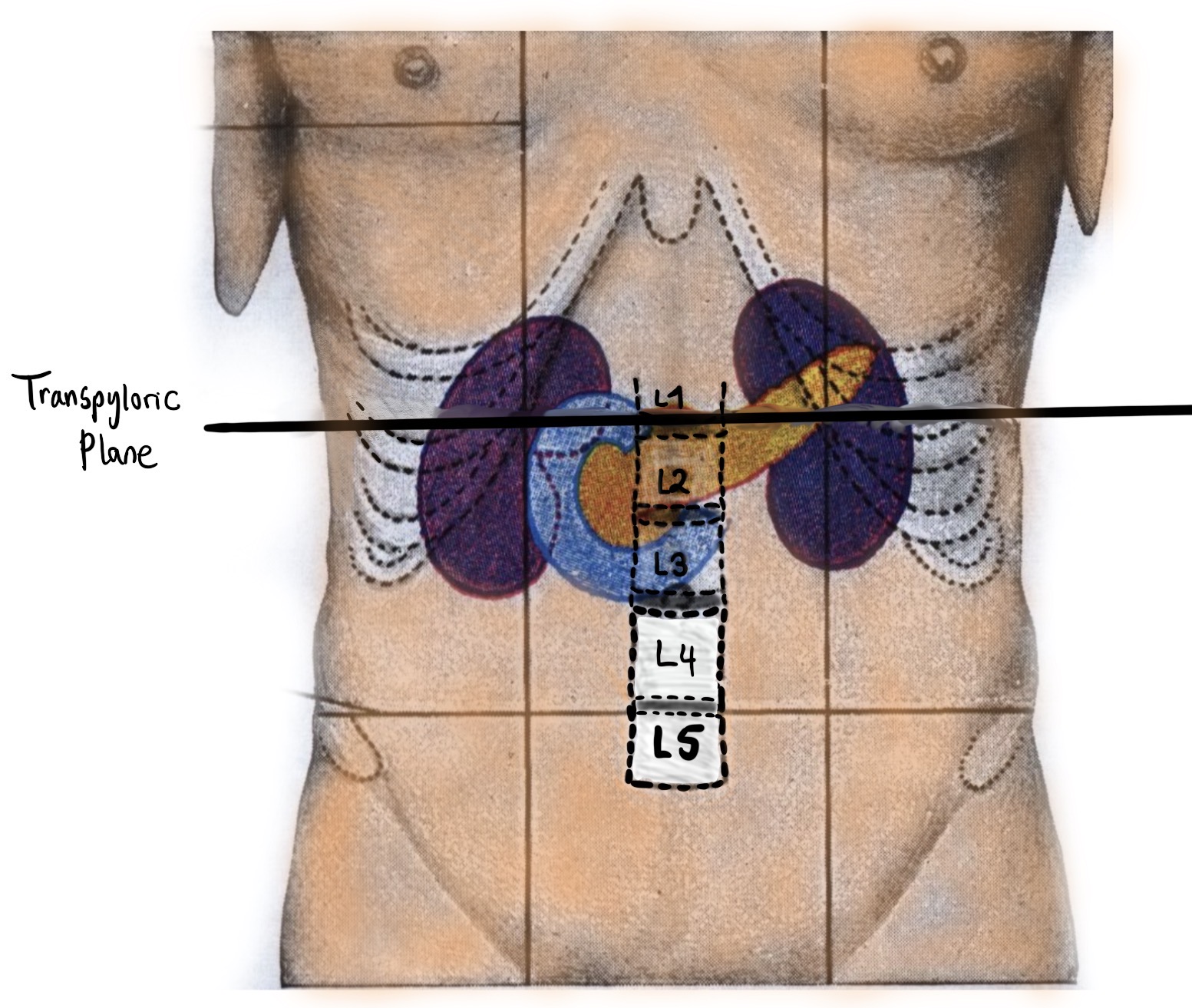
Diagram depicting the level of the transpyloric plane
- Also known as Addison's plane.
- It is an imaginary horizontal line used to landmark various structures within the abdomen.
- It's located halfway between the suprasternal notch (the dip at the top of your sternum) and the pubic symphysis.
- It typically passes through the L1 vertebra and the tips of the ninth costal cartilages on either side.
A drawn diagram of a labelled axial slice of a CT scan showing organs at the level of the Transpyloric plane.
The transpyloric plane is a landmark to the following
Bones
- L1 vertebrae
- 9th costal cartilage
Blood vessels
- Superior Mesenteric Artery (SMA):
- This major artery branches off the abdominal aorta right at the L1 level, typically just below the celiac trunk.
- The SMA is critical as it supplies oxygenated blood to most of the small intestine and the first half of the large intestine.
- Portal Vein Formation:
- The hepatic portal vein, which carries nutrient-rich blood from the digestive tract to the liver, is formed just behind the neck of the pancreas.
- This formation occurs when the superior mesenteric vein (SMV) and the splenic vein merge, usually at or just below the transpyloric plane (around L1-L2).
Spinal Cord:
- Spinal Cord Termination:
- In adults, the spinal cord proper typically ends at the L1/L2 vertebral level.
- The terminal end is a cone-shaped structure called the conus medullaris.
- So, the transpyloric plane marks the approximate end of the solid spinal cord and the beginning of the cauda equina (a bundle of nerve roots).
Lymph
- Cysterna Chyli
- This is a large, dilated sac located in the posterior abdomen that serves as the main collecting point for lymph fluid from the lower body and intestines. It is considered the starting point of the thoracic duct, the body's largest lymphatic vessel. The cisterna chyli is consistently found at the L1/L2 level, right on the transpyloric plane.
Organs:
- Fundus of gall bladder:
- The rounded, bottom part of the gallbladder, called the fundus, typically peeks out from under the liver and touches the abdominal wall at the intersection of the transpyloric plane and the right midclavicular line.
- pyloris of stomach
- 1st part of duodenum:
- The transpyloric plane cuts across the first part of the duodenum (the small intestine's initial segment) and marks the beginning of the second part.
- The sphincter of Oddi, a muscular valve controlling the flow of bile and pancreatic juices into the duodenum, is located in the second part and is therefore very close to this plane.
- DJ flexure:
- This is a sharp bend where the duodenum ends and the jejunum (the next part of the small intestine) begins. The transpyloric plane often passes through this flexure.
- Colon Flexures:
- While slightly variable, the hepatic flexure (where the ascending colon turns to become the transverse colon) and the splenic flexure (where the transverse colon turns to become the descending colon) are located in the general vicinity of this plane.
- The splenic flexure is usually a bit higher and more posterior than the hepatic flexure.
- Renal hilum:
- The hilum of each kidney—the central notch where the renal artery, renal vein, and ureter enter and exit—is located at the L1 level. The left renal hilum is typically slightly superior to the right one.
- Pancreas:
- The neck and body of the pancreas lie directly across the transpyloric plane.
Gastric Curvatures:
The stomach is J shaped featuring a an inner lesser curvature and an outer greater curvature
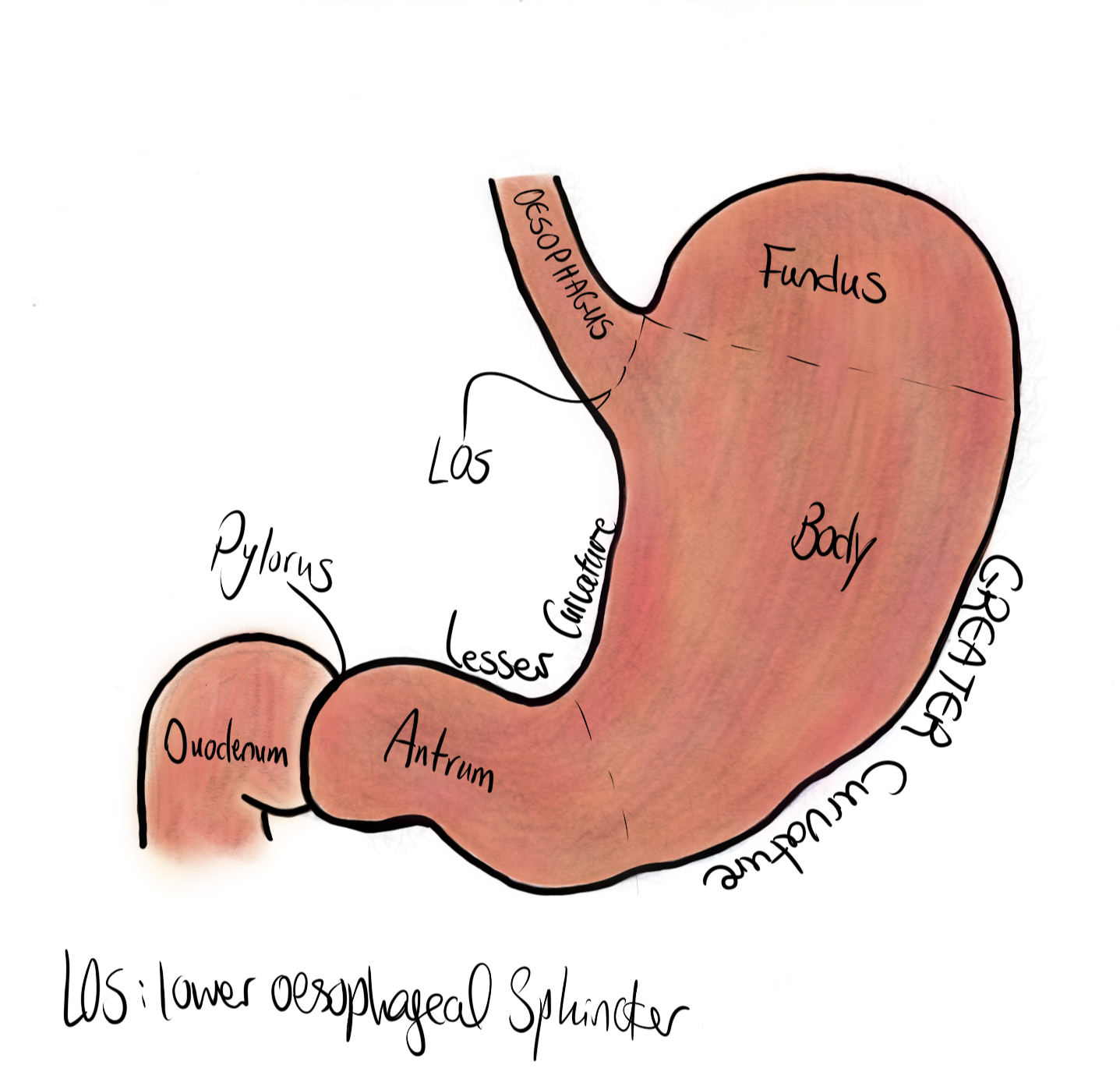
Labelled diagram of the stomach depicting the Gastric Curvatures
The lesser Curvature
- The lesser curvature extends between the cardiac and the pylorus orifices, on the right border of the stomach.
- It is attached to the lesser momentum and contains the right and left gastric vessels adjacent to the line of the curvature.
ُThe Greater Curvature
- It is 4-5 as long as the lesser curvature.
- It starts at the cardia, arches upwards posteriolaterally to the left forming the fundus.
- Its highest point is at the level of the 5th intercostal space just below the nipple in males.
- It then swoops downwards and outwards towards the left reaching the level of the 10th costal cartilage.
- It terminates at the pyloric orifices in the left out border of the stomach.
- Laterally, it attaches the gastrosplenic ligament containing the short gastric vessels.
Blood supply
The blood supply of the stomach originates from various branches of the coeliac trunk.
Coeliac trunk:
- The Coeliac trunk second branch of the abdominal aorta
- It arises from the anterior aspect of the aorta
- It branches below the level at the aortic hiatus of the diaphragm (t12 level)
- It supplies the major organs of the foregut
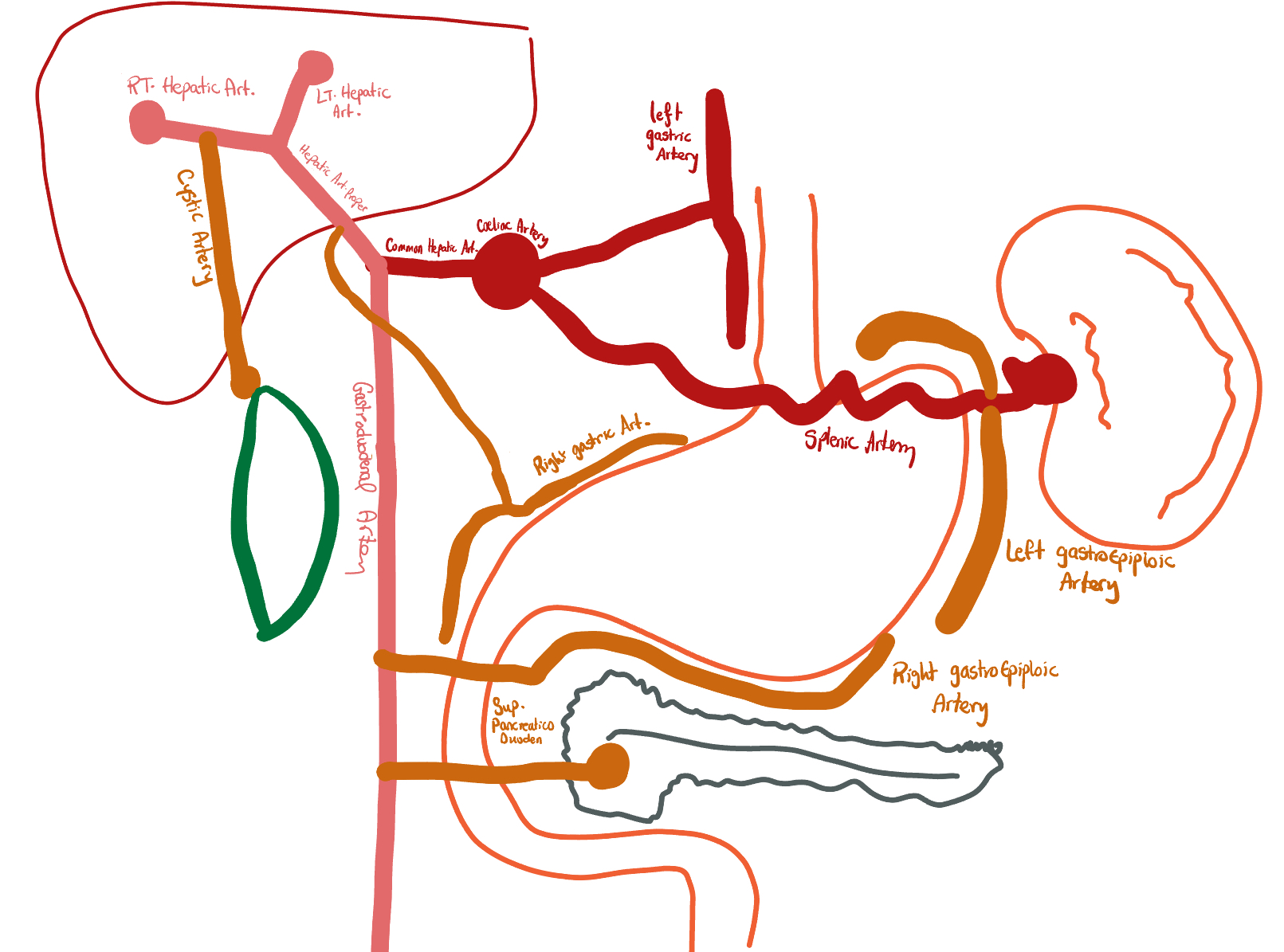
Diagram depicting various branches of the coeliac trunk.
Major branches
The coeliac trunk, a major artery, branches into three main vessels that supply several abdominal organs:
- Left Gastric Artery
- Splenic Artery
- Common Hepatic Artery
Left Gastric Artery
The left gastric artery is the smallest branch of the coeliac trunk. It’s located within the gastrohepatic ligament and ascends over the diaphragm to supply branches to the oesophagus. It then continues along the lesser curvature of the stomach, where it connects (anastomoses) with the right gastric artery.
Tip: Arteries supplying the lesser curvature of the stomach typically have shorter names (e.g., right and left gastric).
Splenic Artery
The splenic artery originates from the coeliac trunk, just below the left gastric artery. It travels leftwards towards the spleen, running behind the stomach and along the upper edge of the pancreas. It’s known for its winding path and is contained within the splenorenal ligament.
It supplies several areas:
- Spleen: Provides five branches to supply different segments of the spleen.
- Left Gastroepiploic Artery: Supplies the greater curvature of the stomach and anastomoses with the right gastroepiploic artery.
- Short Gastric Arteries: Five to seven branches that supply the fundus (top part) of the stomach. These run in the gastrosplenic ligament.
- Pancreatic Branches: Supply the body and tail of the pancreas.
Common Hepatic Artery
The common hepatic artery is the sole arterial supply to the liver and the only branch of the coeliac trunk that passes to the right. It divides into two main branches:
- Proper Hepatic Artery
- Gastroduodenal Artery
Hepatic Artery proper
The proper hepatic artery ascends through the lesser omentum towards the liver. It gives rise to:
- Right Gastric Artery: Supplies the pylorus and lesser curvature of the stomach, running in the lesser omentum.
- Right and Left Hepatic Arteries: These divide just below the porta hepatis and supply their respective lobes of the liver.
- Cystic Artery: A branch of the right hepatic artery that supplies the gallbladder.
Gastroduodenal Artery
The gastroduodenal artery descends behind the upper part of the duodenum. Its branches are:
- Right Gastroepiploic Artery: Supplies the greater curvature of the stomach and also supplies the greater omentum, where it’s found between its layers.
- Superior Pancreaticoduodenal Artery: Divides into anterior and posterior branches, which supply the head of the pancreas.
Stomach Blood Supply
The stomach receives blood from five main vessels: the Left Gastric, Right Gastric, Left Gastroepiploic, Right Gastroepiploic, and short gastric arteries. These vessels form an extensive network (anastomose) on the outer surface (serosal aspect) of the stomach. They also create a deep network of vessels within the muscular, mucosal, and submucosal layers. This rich blood supply ensures the active stomach muscles receive sufficient blood, but it also increases the risk of bleeding from a stomach ulcer.
Regions of Stomach Blood Supply
The blood supply to the stomach can be divided into three main regions:
- Greater Curvature
- Lesser Curvature
- Fundus
What is the blood supply to the lesser curvature of the stomach?
- Right + Left gastric arteries
- Right gastric from common hepatic artery
- Left gastric direct branch of the coeliac axis
What is the blood supply to the greater curvature of the stomach?
- Right and left Gastroepiploic Arteries
- Right Gastroepiploic from the Gastroduodenal Artery
- Left gastroepiploic branch the Splenic Artery
What is the blood supply to the fundus?
- Fundus is supplied by the short gastric arteries which branch from the splenic artery
- found in the Gastrosplenic ligament
Venous supply:
The veins largely follow the arteries and ultimately drain into the splenic vein and superior mesenteric veins.
Lymphatic Drainage
- Follows arteries
- Area of stomach supplied by splenic artery drains via lymphatics accompanying that artery to lymph nodes at the hilum of the spleen, and then to those situated along the upper border of the pancreas and eventually to the coeliac nodes.
- Cardiac area of the stomach drains along the left gastric artery to reach the coeliac nodes.
- The remainder of the stomach drains as follows:
- via branches of the hepatic artery through nodes along the lesser curve to the coeliac nodes
- through nodes along the right gastroepiploic vessels to the subpyloric nodes and then to the coeliac nodes.
- Retrograde spread of carcinoma may occur into the hepatic lymph nodes at the porta hepatis—enlargements of these nodes may cause external compression of the bile ducts with obstructive jaundice.
- Extensive and complex lymphatic drainage of stomach creates problems in dealing with gastric cancer—involvement of nodes around coeliac axis may render growth incurable.
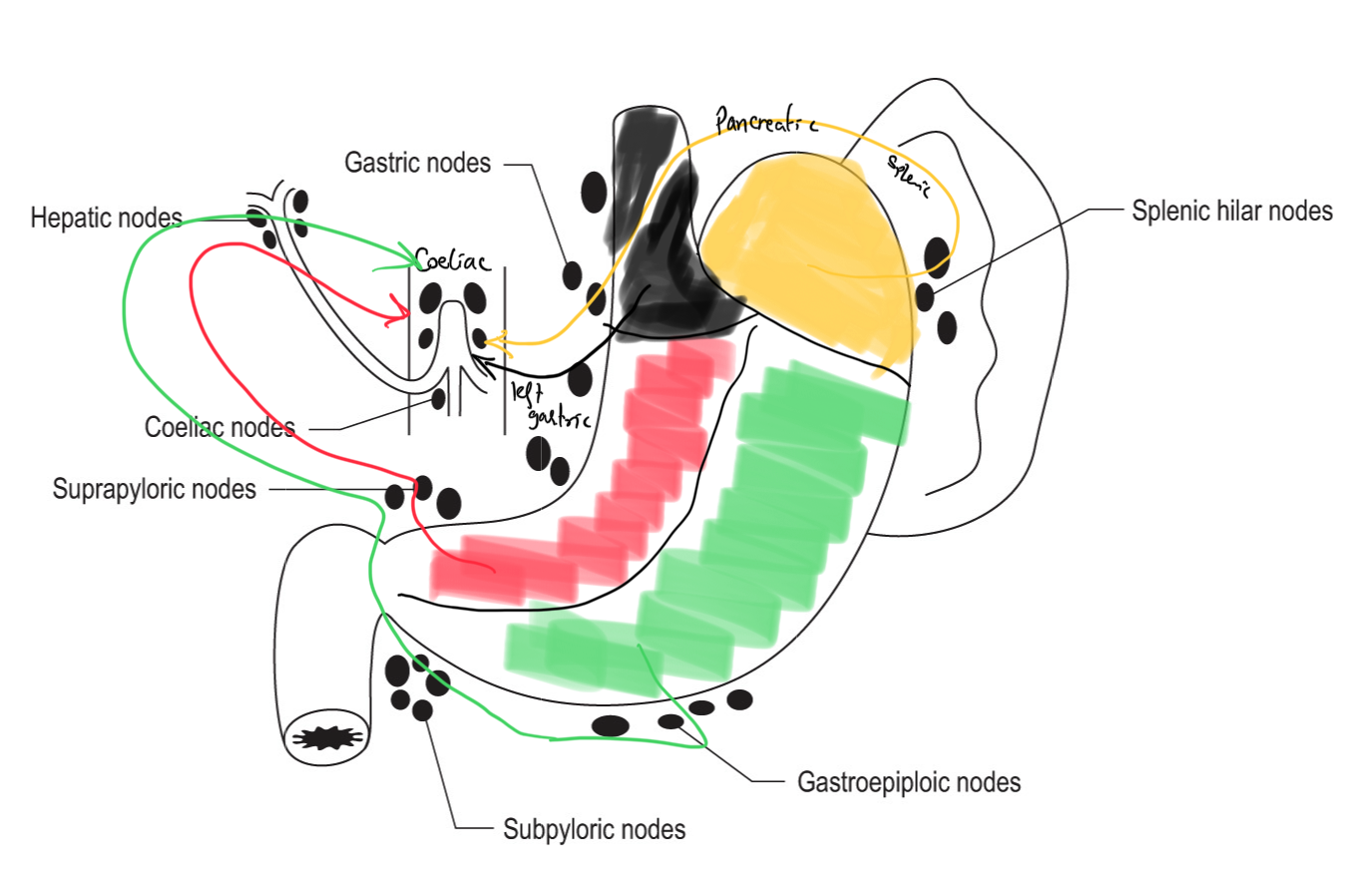
Diagram depicting the lymphatic drainage of the stomach and surrounding lymph nodes.
Nerve supply
The stomach’s nerve supply primarily comes from the vagus nerves, which are part of the parasympathetic nervous system. These nerves play a crucial role in regulating digestion, including stomach acid secretion and muscle contractions (peristalsis).
There are two main vagus nerves involved:
- The anterior (left) vagus nerve and the posterior (right) vagus nerve both enter the abdomen by passing through the oesophageal hiatus in the diaphragm.
- Interestingly, the anterior vagus nerve typically runs very close to the wall of the oesophagus, while the posterior vagus nerve is usually found a little further away.
Branches of the Vagus Nerves
- The anterior vagus nerve gives off several important branches:
- A hepatic branch which travels towards the liver.
- A pyloric branch that specifically supplies the pyloric sphincter, the muscular valve controlling the emptying of the stomach into the small intestine.
- The posterior vagus nerve also has distinct branches:
- A coeliac branch that extends to the coeliac axis, a major arterial trunk supplying abdominal organs.
- After giving off the coeliac branch, it then sends a gastric branch to the posterior surface of the stomach.
Nerves of Latarjet
The main gastric divisions of both the anterior and posterior vagus nerves reach the stomach at the cardia (the upper opening where the oesophagus joins the stomach). From there, they descend along the lesser curve of the stomach, running between the anterior and posterior peritoneal attachments of the lesser omentum. These specific descending branches are collectively known as the anterior and posterior nerves of Latarjet.
Historical Note on Vagotomies
Historically, surgical procedures to intentionally cut or divide the vagus nerve (known as vagotomy) were a common treatment for peptic ulcer disease. The goal was to reduce stomach acid secretion, which the vagus nerve stimulates. However, with significant advancements in medicine, such operations are now rarely performed.
The development of effective medications like H2 receptor antagonists and proton pump inhibitors, which directly reduce acid production, revolutionized ulcer treatment. Furthermore, the discovery of the bacterium Helicobacter pylori as a primary cause of many peptic ulcers and the ability to eradicate it with antibiotics have largely eliminated the need for surgical vagotomy.
Gastric Physiology
Specialised cells of the gastric mucosa
Gastric pits and glands:
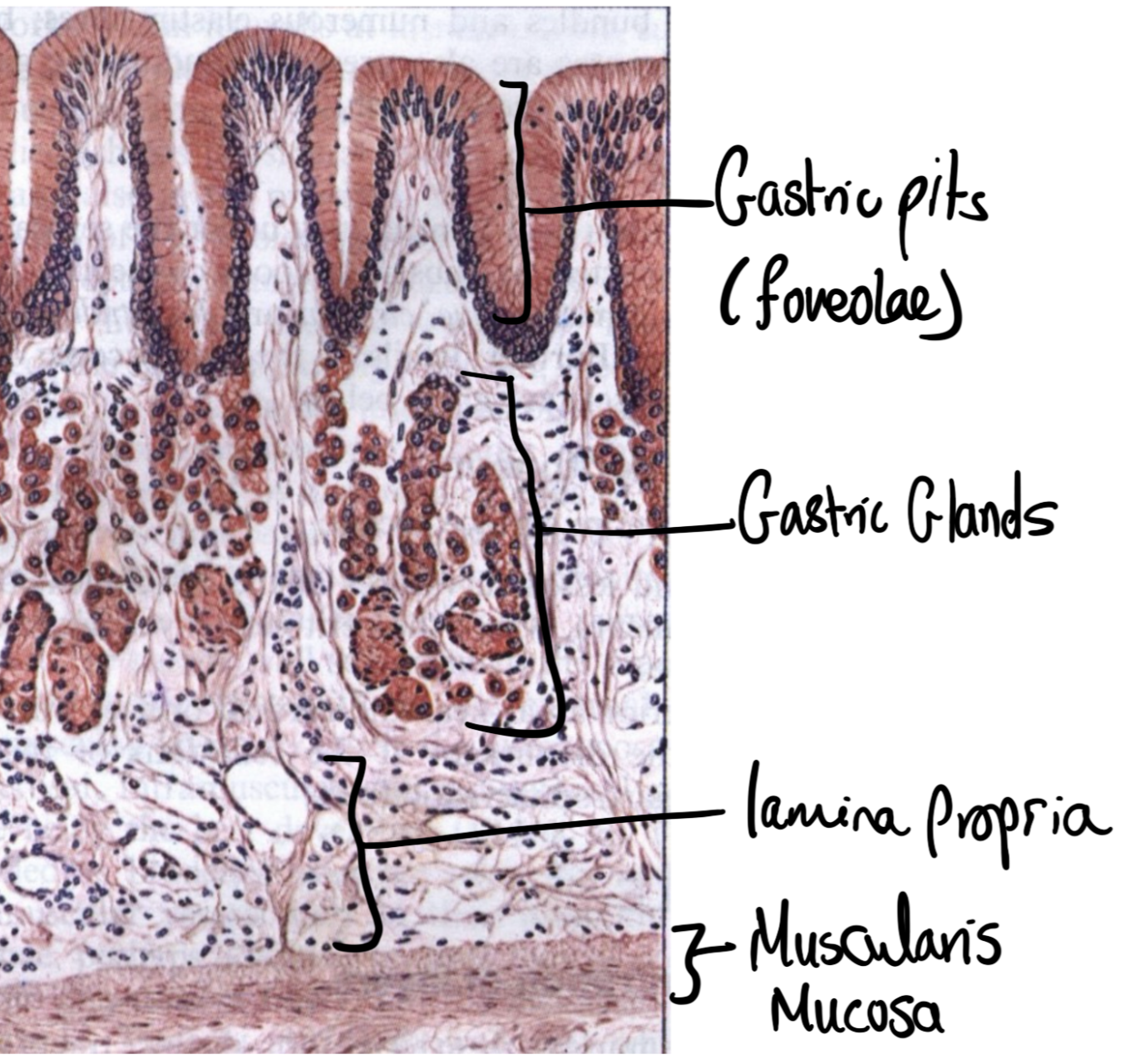
Histology of the gastric pits and glands
- The surface epithelium of the stomach isn't flat, it invaginates (folds inward) to form numerous funnel-like depressions called gastric pits.
- At the bottom of these pits, the gastric glands open. These glands are essentially tubular structures that contain various specialised cells responsible for producing the components of gastric juice.
- They vary in cellular composition and function depending on which region of the stomach they exist. They can be divided to the following categories:
- Cardiac
- principal
- pyloric glands
Cardiac Glands
- Location: These glands are found in the cardia region of the stomach, which is the narrow, initial part of the stomach surrounding the esophagogastric junction. This region is relatively small.
- Function: Their main function is to secrete alkaline mucus. This mucus acts as a protective barrier, lubricating the entering food and, more importantly, helping to neutralize any residual acid that may reflux from the stomach into the esophagus, thus protecting the esophageal lining. This is particularly important given their proximity to the esophagus.
Principal (fundal) Glands
- Location: These are the most numerous and significant glands, located throughout the fundus and body of the stomach. These two regions constitute the largest part of the stomach.
- Function: The principal glands are the workhorses of gastric digestion. Their combined secretions form the bulk of gastric juice, enabling both chemical (protein and limited fat) digestion and creating the optimal acidic environment for enzymatic activity and pathogen elimination.
Pyloric (Antral) Glands
- Location: These glands are found in the pyloric antrum, the lower portion of the stomach that narrows towards the pyloric sphincter, which controls the emptying of stomach contents into the duodenum.
- Function: The primary function of pyloric glands is mucus secretion for protection and, crucially, hormonal regulationof gastric function through the release of gastrin and somatostatin, which play key roles in controlling acid output and stomach emptying.
Cellular composition of the different glands:
Stomach Glands and Their Secretions
Mucous Cells
These cells are the primary component of cardiac glands. They secrete alkaline mucus, which acts as a protective barrier. This mucus helps to lubricate the food as it enters the stomach and, crucially, aids in neutralizing any stomach acid that might reflux into the lower esophagus, thereby preventing damage to the esophageal lining.
Minor Endocrine Cells
While not numerous, cardiac glands may also contain a few scattered endocrine cells. Unlike other regions, they largely lack the acid-producing parietal cells and enzyme-secreting chief cells found elsewhere in the stomach.
Parietal (Oxyntic) Cells
These cells produce hydrochloric acid (HCl), which creates the highly acidic environment (pH 1.5-3.5) necessary for protein denaturation, activation of pepsinogen, and killing of ingested microorganisms. They also secrete intrinsic factor, a glycoprotein vital for vitamin B12 absorption in the terminal ileum of the small intestine.
Chief (Zymogenic/Peptic) Cells
These cells primarily secrete pepsinogen, the inactive precursor to pepsin. Once activated by HCl in the stomach lumen, pepsin becomes a powerful protease, initiating protein digestion. They also secrete gastric lipase, an enzyme involved in the initial, though minor, digestion of fats.
Mucous Neck Cells
Located in the neck region of the principal glands, these cells produce a thinner, less alkaline mucus compared to the surface mucous cells found throughout the stomach lining. This mucus contributes to the protective layer of the stomach.
Enterochromaffin-like (ECL) Cells
These are neuroendocrine cells that secrete histamine. Histamine acts as a potent paracrine stimulant, directly promoting and increasing parietal cell acid secretion, thereby playing a key role in regulating stomach acidity.
D-cells and Ghrelin-secreting Cells
D-cells secrete somatostatin, a hormone that inhibits HCl secretion and gastric motility, providing a feedback mechanism. Ghrelin-secreting cells (also known as X/A-like cells), also found in the fundus, secrete ghrelin, often called the “hunger hormone,” which stimulates appetite.
Mucous Cells
Similar to cardiac glands, pyloric glands are predominantly composed of mucous cells. These cells primarily secrete mucus, which helps to neutralize the acidic chyme before it enters the duodenum and provides a vital protective layer for the pyloric mucosa.
G-cells
These are crucial enteroendocrine cells that secrete the hormone gastrin. Gastrin is released into the bloodstream and travels to the principal glands, where it stimulates parietal cells (both directly and indirectly via ECL cells) to increase HCl secretion and promotes gastric motility.
D-cells
Also present in the pyloric glands, D-cells secrete somatostatin. This hormone acts to inhibit gastrin release and thereby reduces acid secretion. This provides an essential negative feedback mechanism that helps regulate stomach acidity and function.
Summary table of the different specialised cells
Specialized Cell Type |
Primary Location in Gastric Glands |
Key Secretion(s) |
Primary Function(s) |
|---|---|---|---|
Surface Mucous Cells |
Surface epithelium, lining gastric pits, cardiac glands |
Alkaline Mucus |
Forms a protective, viscous, alkaline barrier against acid and mechanical abrasion. |
Parietal Cells |
Principal Glands (Body & Fundus) |
Hydrochloric Acid (HCl), Intrinsic Factor |
HCl: Denatures proteins, activates pepsinogen, kills microbes. Intrinsic Factor: B12 absorption. |
Chief Cells |
Principal (Fundic/Oxyntic) Glands (Body & Fundus) |
Pepsinogen, Gastric Lipase |
Pepsinogen: Precursor to pepsin (protein digestion). Gastric Lipase: Minor fat digestion. |
G-cells |
Pyloric Glands (Pyloric Antrum) |
Gastrin |
Stimulates HCl secretion from parietal cells (directly & via ECL cells); promotes motility. |
Enterochromaffin-like (ECL) Cells |
Principal (Fundic/Oxyntic) Glands (Body & Fundus) |
Histamine |
Potent stimulator of HCl secretion from parietal cells. |
D-cells |
Principal (Fundic/Oxyntic) Glands, Pyloric Glands |
Somatostatin |
Inhibits gastrin release and HCl secretion (feedback inhibition). |
Ghrelin-secreting cells (X/A-like cells) |
Principal (Fundic/Oxyntic) Glands (Body & Fundus) |
Ghrelin |
“Hunger hormone”; stimulates appetite and growth hormone release. |
Controls and mechanisms of gastric juice secretion
This section focuses on the gastric juice secreted by specialised cells of the gastric mucosa.
This has 4 major components:
- HCl: Involved in the chemical digestion of proteins and reducing PH to activate pepsinogen.
- Pepsinogen: This is activated by HCl to pepsin, an enzyme which digests protein
- Intrinsic factor: This allows the absorption of B12 in the ileum.
- Mucus: protects the gastric mucosa from the corrosive action of HCl and lubricates gastric contents.
HCL secretion mechnism
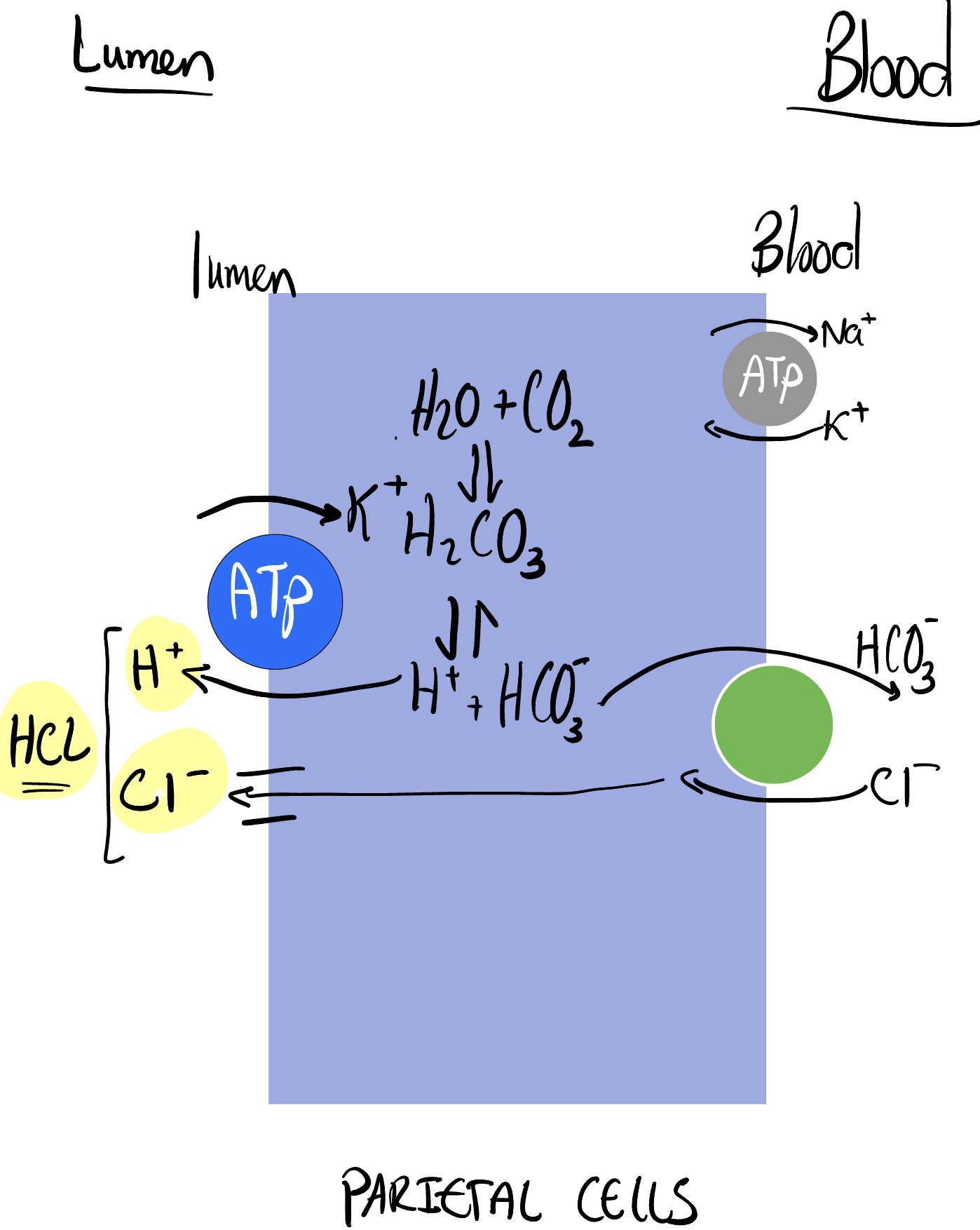
A diagram depicting the parietal cell and proton pump mechanism
H+ formation (the proton pump)
In intracellular fluid, Carbon Dioxide (CO2) produced by aerobic respiration of parietal cells reacts with H2O forming H2CO3. This reaction is catalysed by Carbonic Anhydrase.
H2CO3 dissociates into down H+ and HCO3- ions. The H+ ions are actively pumped into the gastric lumen by the “proton pump”. This process requires ATP.
Chloride ions and formation of HCl
HCO3- produced from the above process leaves the cell into the blood via the Cl- – HCO3- exchanger.
The absorbed HCO3− is responsible for the “alkaline tide” (high pH) that can be observed in gastric venous blood after a meal.
Eventually this HCO3− will be secreted back into the gastrointestinal tract in pancreatic secretions.
The chloride ions coming into the cell in exchange of HCO3- will be release into the gastric lumen to react with Hydrogen ions forming HCl.
Substances that alter HCl secretion
Gastric HCl secretion is precisely controlled in three sequential and overlapping phases:
- Cephalic Phase (30%): Triggered by sensory cues (smell, taste) and anticipation of food. Mechanisms involve direct vagal stimulation of parietal cells (ACh release) and indirect vagal stimulation of G cells to release gastrin (via GRP), which then stimulates parietal cells.
- Gastric Phase (60%): Initiated by food in the stomach, specifically stomach distention and protein digestion products (amino acids, small peptides). Mechanisms include direct and indirect vagal stimulation (from distention), local reflexes (from antral distention), and direct chemical stimulation of G cells by protein breakdown products. Alcohol and caffeine also stimulate this phase.
- Intestinal Phase (10%): A minor phase stimulated by protein digestion products entering the small intestine.
These phases collectively ensure that sufficient acid is produced for digestion, more details on how individual hormones work is below
Substances that stimulate H+ secretion:
Histamine:
- Histamine, released from ECL cells in the gastric mucosa, acts as a paracrine messenger, diffusing to nearby parietal cells.
- There, it binds to H2 receptors, activating the intracellular messenger Gs protein.
- Gs protein activates adenylyl cyclase, leading to an increase in intracellular cAMP.
- Elevated cAMP then activates protein kinase A, ultimately stimulating the parietal cells to secrete H+ (hydrochloric acid).
Drugs like Famotidine block these H2 receptors, thereby inhibiting histamine's effect on acid secretion.

A Diagram depicting the effects of histamine on the proton pump
Gastrin:
- Produced by G cells located in the mucosal glands of the gastric antrum.
- Gastrin operates via an endocrine mechanism: it is released into the systemic circulation from the antrum, travels throughout the body, and then returns to the stomach to act on its target cells.
- Upon reaching the parietal cells, gastrin specifically binds to cholecystokinin B (CCKB) receptors.
- Binding of gastrin to the CCKB receptor initiates an intracellular signaling cascade involving the IP3/Ca2+ second messenger system
- This pathway is also utilized by acetylcholine to stimulate acid secretion (see below). This ultimately leads to enhanced H+ secretion by the parietal cells.
Acetylcholine (ACh):
- Released from vagus nerves that innervate the gastric mucosa, plays a dual role in stimulating gastric acid (H+) secretion from parietal cells.
- Firstly, ACh acts directly on parietal cells by binding to muscarinic (M3) receptors.
- This initiates an intracellular signaling cascade involving the IP3/Ca2+ second messenger system.
- ACh also indirectly enhances H+ secretion by stimulating ECL cells within the gastric mucosa to release histamine, which then acts on parietal cells via H2 receptors to further promote acid production.
Pharmacologically, atropine serves as a muscarinic receptor antagonist, blocking ACh's direct stimulatory effect on parietal cells and thereby reducing H+ secretion.
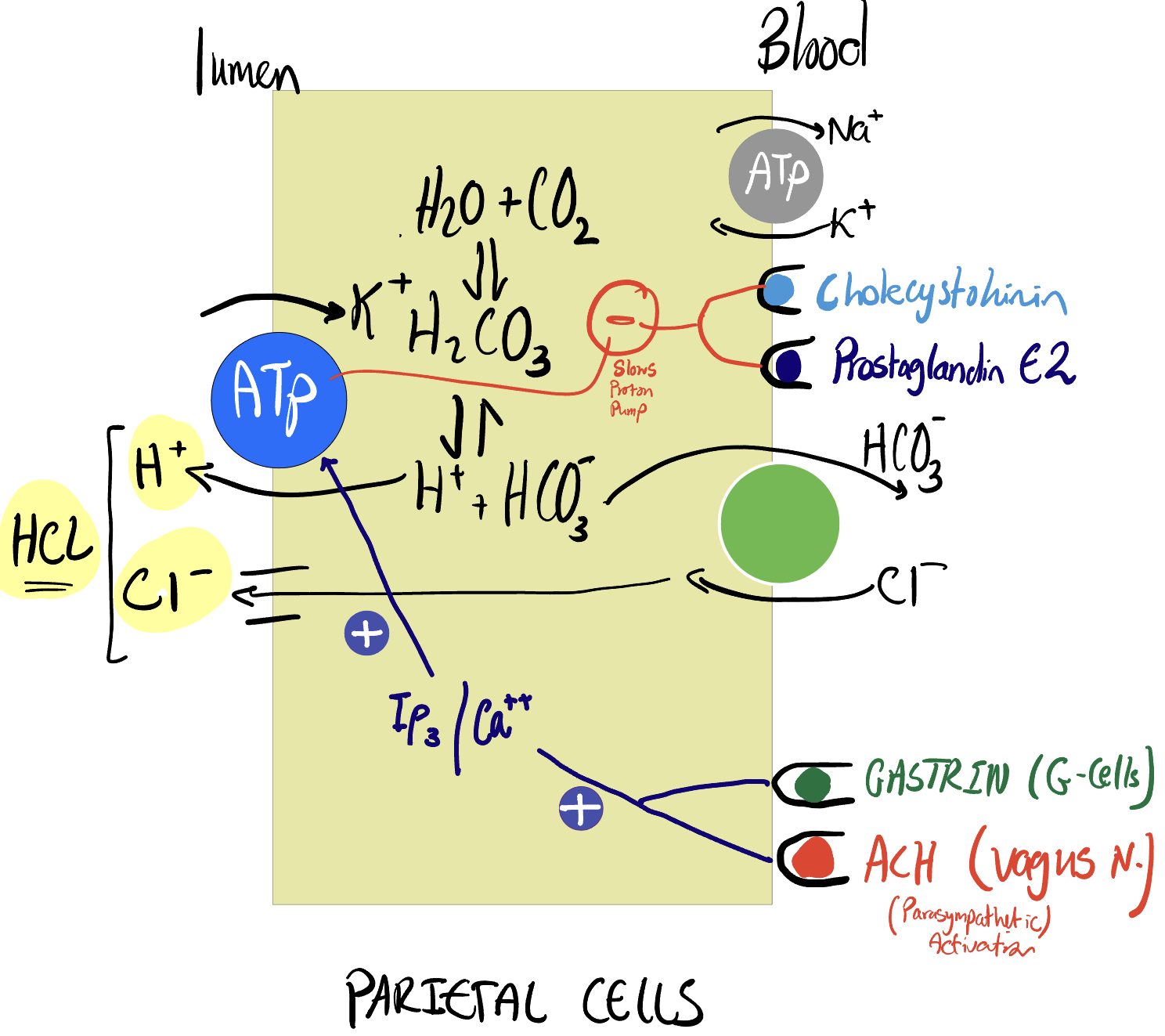
Diagram depicting the effects of various hormones on the proton pump
Factors that inhibit production of HCl
- HCl secretion is primarily inhibited when stomach acid is no longer needed, particularly after chyme has moved into the small intestine. This need is signaled by a decrease in gastric pH.
- The main inhibitory hormone for H+ secretion is somatostatin, released by gastric D cells. Somatostatin inhibits H+ secretion through both direct and indirect pathways:
- Direct Pathway: Somatostatin binds to receptors on parietal cells, activating a Gi protein. This inhibits adenylyl cyclase, reducing cAMP levels, and thus counteracting the stimulatory effect of histamine.
- Indirect Pathways: Somatostatin also inhibits histamine release from ECL cells and gastrin release from G cells, thereby reducing the overall stimulatory drive on parietal cells.
- Similarly, prostaglandins (like prostaglandin E2) also inhibit H+ secretion by activating a Gi protein and inhibiting adenylyl cyclase, mirroring somatostatin's direct action against histamine's effects.
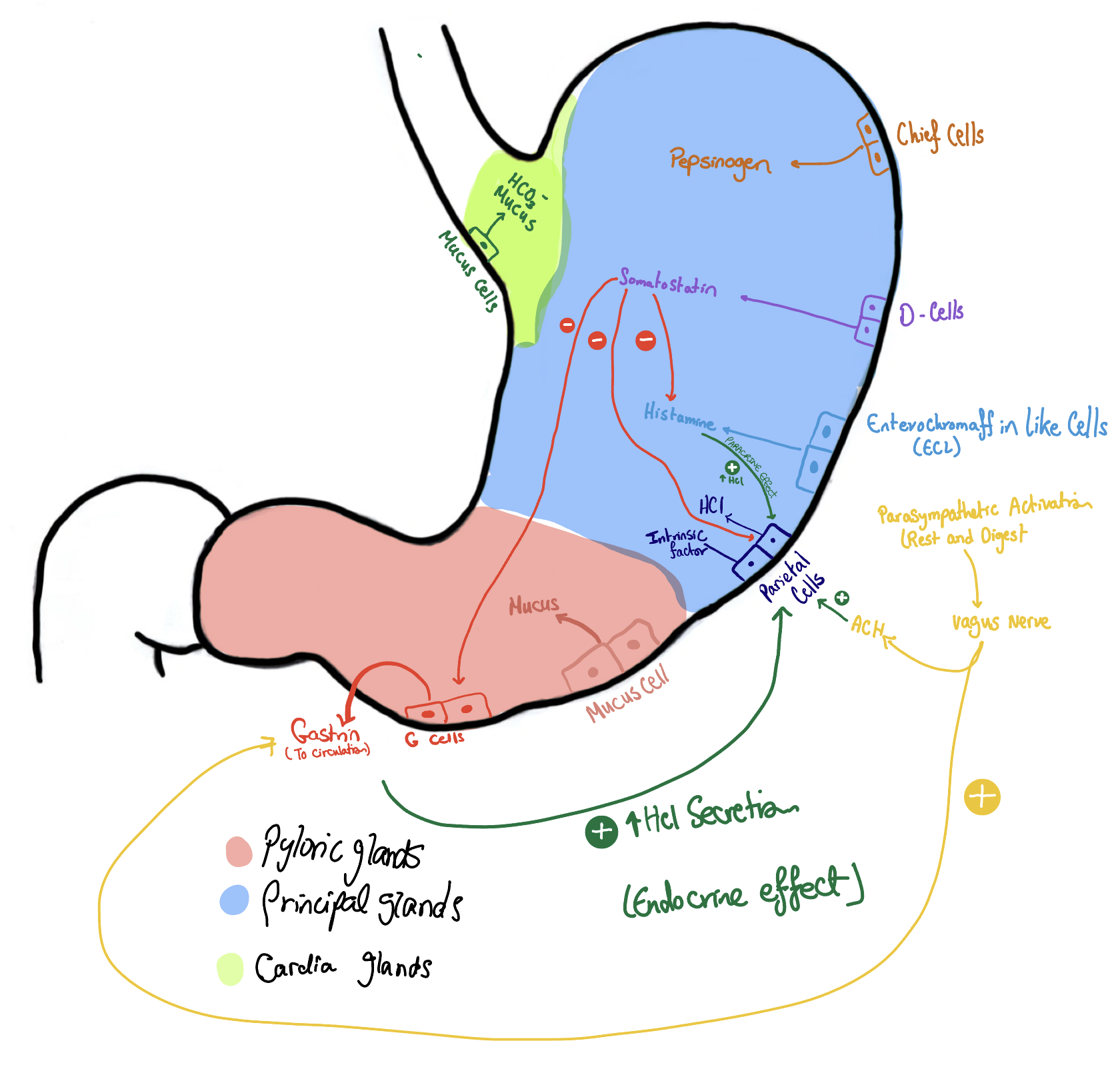
Diagram summarising factors affecting HCl secretion
Histology of the stomach
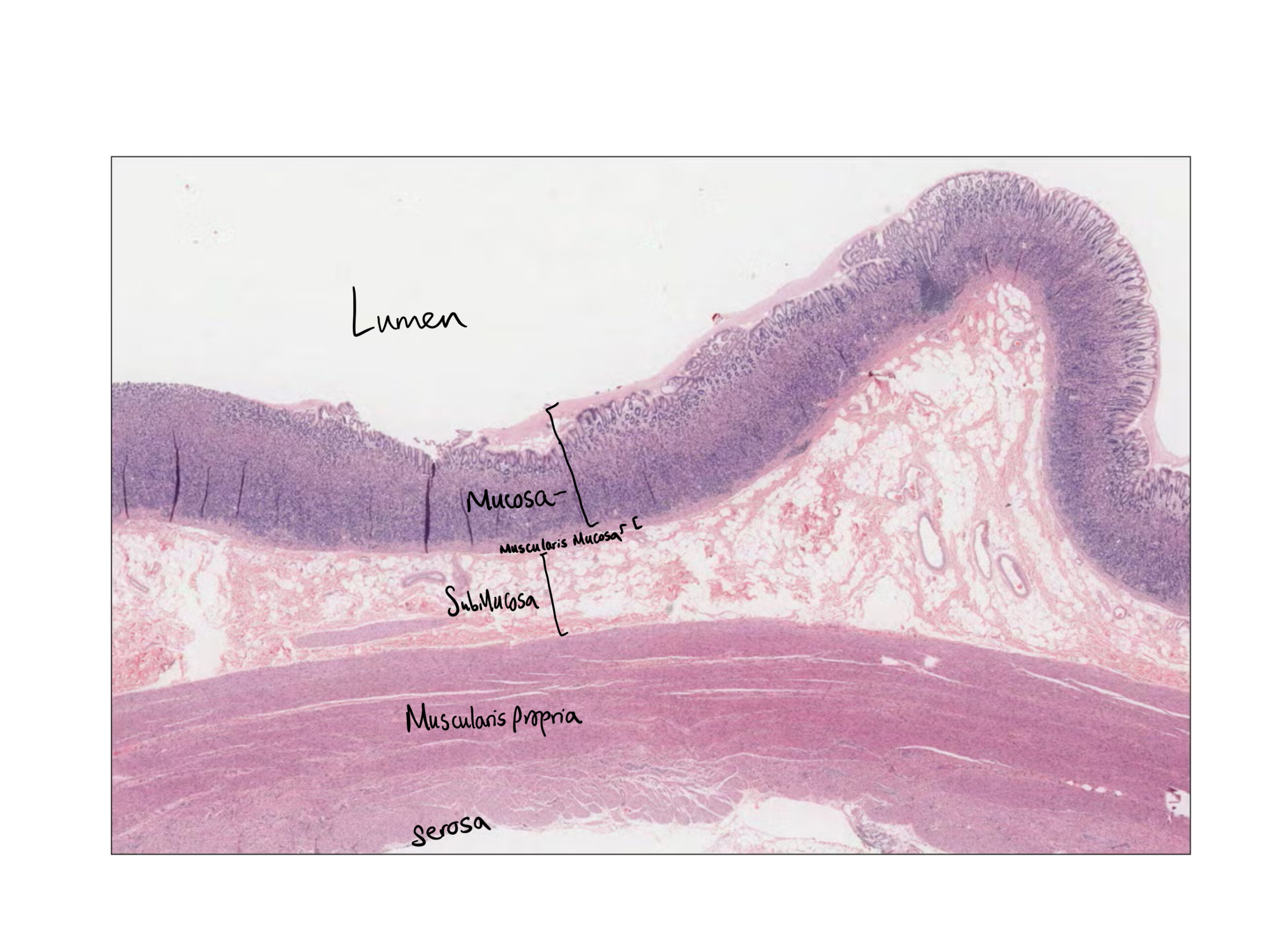
- The gastric wall consists of the major layers found elsewhere in the gut (i.e. mucosa, submucosa, muscularis externa, serosa.
- These structures are adapted to the functions of the stomach as an expandable muscular sac lined by secretory acid resistant epithelium.
- In the contracted stomach, the stomach wall is folded into numerous folds or rugae.
- Those are large folds in the submucosal connective tissue, which are obliterated when the stomach is stretched and distended.
Mucosa
The gastric mucosa is the innermost lining of the stomach, and its formation and maintenance are crucial for proper digestion and protection against the stomach's own corrosive digestive juices.
The gastric mucosa, like other structures of the gut, is formed of 3 layers:
- Surface epithelium
- lamina propria
- muscular mucosa

Diagram depicting layers of the gastric muc
The surface epithelium
- This is the surface layer, made of simple columnar epithelial cells.
- These cells are responsible for secreting a thick, gel-like mucus that forms a protective barrier over the stomach lining.
- The epithelium commences at the cardiac orifice, where there is a sudden transition from the oesophageal stratified epithelium.
- This point of transition is called the Z line
The "Z-line" (Squamocolumnar Junction):
This is the abrupt, often zig-zagging line where the two distinct types of epithelial lining meet:
- Stratified squamous epithelium of the esophagus: This is the type of lining found in the upper digestive tract, similar to skin, designed for protection against abrasion from food passage. It typically appears paler pink on endoscopy.
- Simple columnar epithelium of the gastric cardia (stomach): This lining is specialized for secretion and absorption, and it's adapted to the acidic environment of the stomach. It typically appears salmon-colored or redder.
- The zig-zag appearance is due to the interdigitation of these two different tissue types.
Gastric pits and glands:
- The surface epithelium of the stomach isn't flat; it invaginates (folds inward) to form numerous funnel-like depressions called gastric **pits.
- At the bottom of these pits, the gastric glands open. These glands are essentially tubular structures that contain various specialised cells responsible for producing the components of gastric juice.
- They vary in cellular composition and function depending on which region of the stomach they exist:
- They can be divided to the following categories;
- Cardiac
- principal
- pyloric glands
- They can be divided to the following categories;
More on their function in the physiology tab!
Other layers of the mucosa
- Lamina Propria: This is a layer of loose connective tissue located beneath the epithelium. It provides structural support, contains blood vessels (for nutrient supply and acid neutralization), nerves, and various immune cells.
- Muscularis Mucosae: This is the deepest layer of the mucosa, consisting of a thin layer of smooth muscle. Its contractions help with local movements of the mucosa, influencing gland secretion and the overall surface area.
Submucosa:
The submucosa lies superficial the mucosa and is composed of dense irregular connective tissue.
- Composition: It contains larger blood vessels, lymphatic vessels, and the submucosal plexus (Meissner's plexus), a network of nerves from the enteric nervous system.
- The substantial blood supply here supports the metabolic demands of the overlying mucosa, particularly the acid-secreting parietal cells. The lymphatic vessels are important for fluid balance and immune surveillance.
Muscularis Propria
This is the main muscular layer of the stomach, responsible for its powerful churning movements. Unlike most of the GI tract which has two layers of smooth muscle, the stomach's muscularis propria has three distinct layers:
- Inner Oblique Layer: This is the innermost and unique layer to the stomach, running obliquely.
- Middle Circular Layer: This layer is particularly thick at the pylorus, forming the pyloric sphincter.
- Outer Longitudinal Layer: This is the outermost smooth muscle layer.
These three layers contract in coordinated but diverse patterns to thoroughly mix the food with gastric juices and to mechanically pulverize it into chyme. The oblique layer contributes to the grinding and pulverizing motions, while the circular and longitudinal layers are responsible for peristaltic waves that propel chyme towards the pylorus.
The serosa
The serosa is the outermost layer of the stomach wall.
- Composition: It consists of a thin layer of loose connective tissue covered by a simple squamous epithelium (mesothelium). It is continuous with the visceral peritoneum.
- Functional Relation: The serosa provides a smooth, slippery outer surface that reduces friction as the stomach moves and rubs against other abdominal organs. It also provides structural support and anchors the stomach within the abdominal cavity.
Select a Clinical Topic
Please choose a specific pathology from the submenu to see the relevant clinical details.
Helicobacter Pylori
Definition:
Helicobacter Pylori is a slow growing spiral Gram negative flagellated urease producing bacteria.
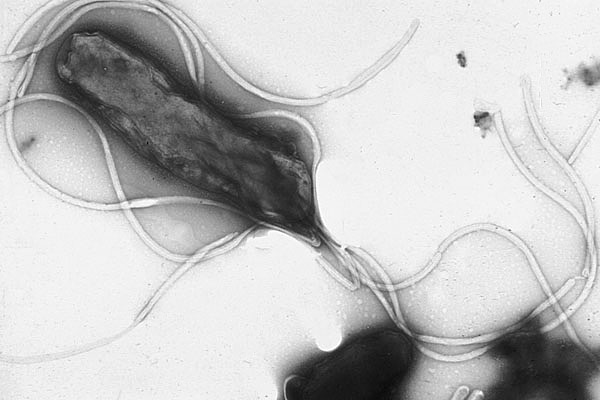
Helicobacter Pylori Bacteria
Definition explanation
"Helicobacter pylori"
This is the scientific name of the organism, and the name itself gives us clues.
- Helico-: This prefix comes from the Greek word helikos, meaning "spiral" or "helix". It refers to the bacterium's distinctive spiral shape.
- bacter: This suffix simply means "bacterium".
- pylori: This refers to the pylorus or pyloric antrum, which is the part of the stomach that connects to the small intestine. This is the primary region where the bacterium colonises, hence its name: the "spiral bacterium of the pylorus".
"slow growing"
- This describes its rate of reproduction.
- Compared to many other common bacteria (like E. coli, which can double its population in 20 minutes under ideal conditions), H. pylori divides and multiplies very slowly.
- This has practical implications for laboratory diagnosis, as it can take several days to grow a visible culture from a patient's biopsy sample.
"spiral"
- This refers to its physical shape, which resembles a corkscrew.
- This shape is not just a visual characteristic; it's a crucial tool for its survival. It allows the bacterium to physically drill and burrow through the thick, viscous mucus layer that coats and protects the stomach lining.
- This enables it to get away from the highly acidic environment of the open stomach and reach the more protected surface of the epithelial cells underneath.
"Gram negative"
This is a fundamental classification in microbiology based on a staining procedure called the Gram stain.
- In the lab, bacteria are stained with a purple dye (crystal violet).
- They are then washed with an alcohol solution.
- Gram-positive bacteria have a very thick outer cell wall (made of peptidoglycan) that traps the purple dye, so they remain purple.
- Gram-negative bacteria, like H. pylori, have a much thinner peptidoglycan wall and an additional outer membrane. The alcohol wash removes the purple dye, and a red counterstain (usually safranin) is added, making them appear pink or red under a microscope. This tells a microbiologist about the bacterium's cell wall structure, which can be important for predicting its susceptibility to certain antibiotics.
"Flagellated"
- This means the bacterium is equipped with flagella.
- Flagella are long, whip-like tails that act like propellers.
- H. pylori has several of these flagella at one end. They spin to propel the bacterium, allowing it to be highly motile (able to move).
- This motility is essential for it to swim through the stomach's mucus and position itself correctly for colonisation.
"urease producing"
This is arguably the most important key to H. pylori's survival in the stomach, one of the most hostile environments in the human body.
- Urease is an enzyme.
- "Producing" means the bacterium actively manufactures and secretes this enzyme.
- The function of urease is to break down urea (a compound naturally found in gastric juice) into ammonia (NH3)and carbon dioxide (CO2).
- Ammonia is a weak base, which means it neutralises acid.
By producing urease, H. pylori surrounds itself with a cloud of ammonia, neutralising the potent stomach acid in its immediate vicinity. This creates a small, survivable "microenvironment" with a more neutral pH, protecting it from being destroyed and allowing it to thrive where most other bacteria cannot.
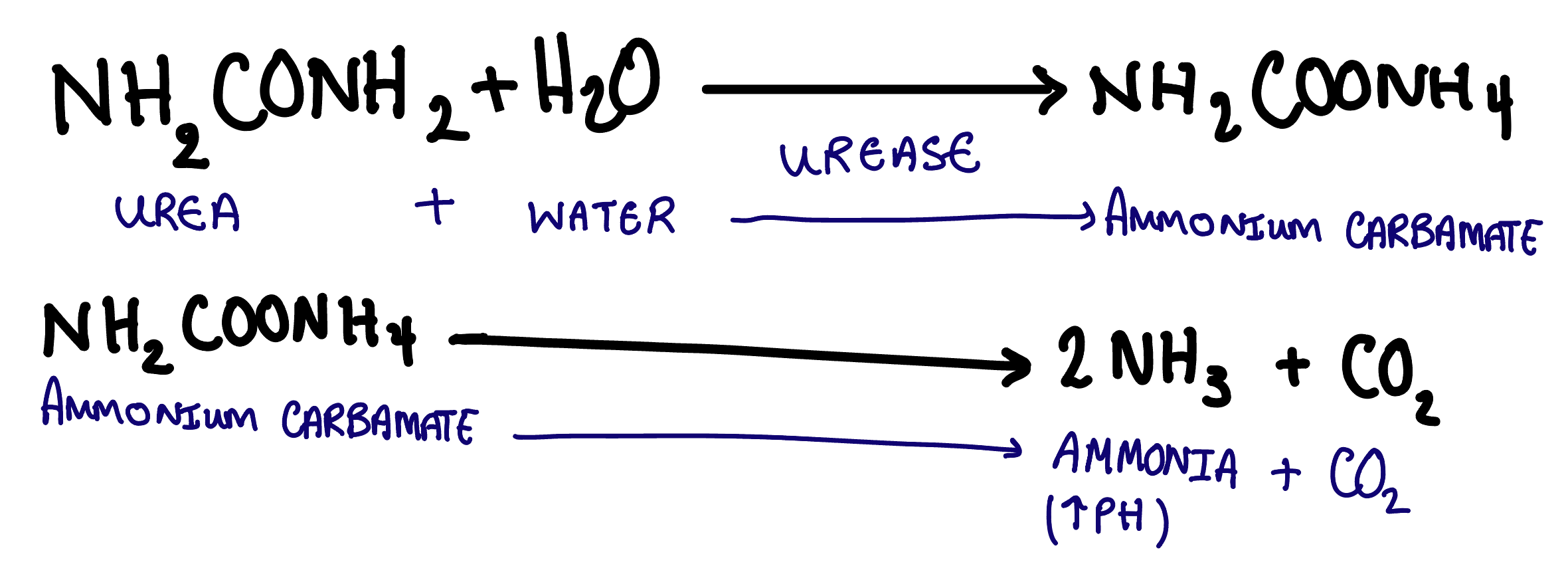
Urea broken down to ammonia, catalysed by urease
Epidemiology:
- 50% of the world’s population is estimated to be currently infected.
- H pylori incidence is very high in developing countries (over 80%). The incidence is much lower in developed countries (20-30%).
- The exact transmission mode isn’t clear, but for the general population, the most likely mode of transmission is thought to be from person to person, by either the oral-oral route (through vomitus or possibly saliva) or perhaps the faeco-oral route.
- The person-to-person mode of transmission is supported by the higher incidence of infection among institutionalised children and adults and the clustering of H. pylori infection within families.
- Also lending support to this concept is the detection of H. pylori DNA in vomitus, saliva, dental plaque, gastric juice, and faeces.
- Waterborne transmission, probably due to fecal contamination, may be an important source of infection, especially in parts of the world in which untreated water is common.
Pathogenesis:
- The majority of the colonised population remain asymptomatic their entire life.
- H.Pylori infections can present as gastritis, peptic ulcers in the duodenum or stomach) and gastric cancer (see peptic ulcer’s notes).
- 95% of duodenal and 70–80% of gastric ulcers are associated with H.Pylori infections
How H.Pylori damages cells in the stomach?:
This section explains the different strategies the bacterium uses to survive, damage the stomach lining, and cause disease. The severity of the disease often depends on a combination of the specific bacterial strain and the host's genetic makeup.
- Colonisation: Sticking to the Stomach Wall
- H. pylori doesn't just float around in the stomach; it specifically targets and attaches to the cells of the stomach lining (the gastric epithelium). To do this, it uses specialised "adhesion molecules" on its surface that act like molecular glue.
- A key example is an adhesin called BabA. This molecule binds tightly to a specific sugar structure on the surface of stomach cells called the Lewis B antigen.
- This firm attachment allows the bacteria to survive longer in the stomach.
How does H pylori causes disease:
- Direct Cell Damage by enzymes:
- H.Pylori releases various enzymes that can directly degrade the stomach's protective layers and damage the cells themselves.
- Inducing Apoptosis (Programmed Cell Death):
- H. Pylori can interact with specific molecules on the surface of stomach cells called MHC class II molecules.
- Normally, these molecules are used by your immune system to communicate. H. pylori hijacks this system, and its binding sends a signal that tells the stomach cell to self-destruct. This process of controlled cell death is called apoptosis.
- Toxic By-products of Urease
- We know urease is crucial for survival because it produces ammonia to neutralise stomach acid. However, this process also creates by-products that are directly toxic to your cells.
- Urease converts urea into ammonium and other compounds (like monochloramine when it reacts with other substances in the stomach). These chemicals are cytotoxic, meaning they are poisonous to the gastric epithelial cells, causing further injury.
- CagA and VacA genes:
- The ones most strongly associated with severe diseases like peptic ulcers and stomach cancer carry specific genes called CagA and VacA.
- VacA (Vacuolating Toxin): This is a toxin that, when secreted by the bacterium, inserts itself into stomach cells and forms pores or channels. This disrupts the cell's normal function and can trigger apoptosis. It gets its name because it causes large bubbles (vacuoles) to form inside cells.
- CagA (Cytotoxin-associated Gene A): Strains with the cag pathogenicity island (a block of extra genes) can act like a molecular syringe. They inject the CagA protein directly into the stomach's epithelial cells. Once inside, CagA interferes with the cell's internal signalling, disrupting its structure, growth, and adhesion to other cells. This promotes inflammation and is strongly linked to a higher risk of ulcers and cancer.
- Triggering a Massive Inflammatory Response
- The presence of H. pylori, and especially the injection of the CagA protein, puts the body's immune system on high alert.
- Infected stomach cells release signalling molecules called cytokines to call for help. The strains with CagA and VacA are particularly potent at inducing the release of Interleukin-8 (IL-8).
- IL-8 is a powerful chemical messenger that attracts immune cells (especially neutrophils) to the site of infection. This flood of immune cells is the direct cause of the intense and chronic inflammation (gastritis) that damages the stomach tissue over time.
Patterns of H.Pylori infections:
The location of the primary infection in the stomach determines the type of disease that is most likely to develop. There are two main patterns: one that leads to duodenal ulcers and another that can lead to stomach cancer.
Pattern 1: Antral-Predominant Gastritis (Leading to Duodenal Ulcers)
This pattern occurs when the H. pylori infection is concentrated in the lower part of the stomach, known as the antrum.
- The Problem: Hormonal Imbalance and Excess Acid
- Infection Site: H. pylori colonises the antrum. The body of the stomach, where most acid is made, is largely spared.
- Hormone Disruption: The inflammation in the antrum disrupts the cells that regulate acid production. It causes a decrease in somatostatin (the "brake pedal" for acid production) and an increase in gastrin (the "accelerator").
- Hypersecretion of Acid: With the foot on the accelerator and the brakes failing, the stomach's parietal cells are overstimulated and produce an excessive amount of acid.
- How This Causes Duodenal Ulcers
- Acid Overload: This high volume of acid is emptied from the stomach into the duodenum (the first part of the small intestine).
- Protective Change (Metaplasia): The duodenum is not designed to handle this much acid. As a defense mechanism, its lining begins to change, transforming into stomach-like tissue. This process is called gastric metaplasia.
- New Site for Infection: Since H. pylori can only colonise gastric (stomach) tissue, these new patches of metaplastic tissue in the duodenum become perfect new homes for the bacteria.
- Ulcer Formation: H. pylori colonises these patches, causing localised inflammation and damage that eventually erodes the lining, creating a duodenal ulcer.
Pattern 2: Pangastritis (Leading to Gastric Cancer)
This pattern occurs when the infection and inflammation are spread throughout the entire stomach, including both the antrum and the main body (corpus). This pathway is a multi-step process often called the "Correa cascade".
- The Problem: Stomach Atrophy and Low Acid
- Widespread Inflammation: Chronic inflammation throughout the stomach damages all the specialised glands.
- Gastric Atrophy: Over many years, this damage leads to gastric atrophy, which is the wasting away and loss of the normal stomach lining. Critically, this includes the destruction of the parietal cells in the stomach body.
- Result: Hyposecretion of Acid: With the parietal cells gone, the stomach can no longer produce enough acid. This condition is known as hypochlorhydria (low acid). This is the opposite of the duodenal ulcer pathway.
- The Pathway to Gastric Cancer (Intestinal-Type Adenocarcinoma)
- Intestinal Metaplasia: In this new, low-acid environment, the damaged stomach lining tries to heal but does so abnormally. It transforms into tissue that looks and acts like the lining of the intestines. This is called intestinal metaplasia and is considered a pre-cancerous condition.
- Dysplasia: Over time, this abnormal intestinal-type tissue can accumulate more genetic errors and develop into dysplasia, a state where the cells are highly disorganised and more cancer-like.
- Cancer: If left unchecked, dysplasia can progress into gastric adenocarcinoma, the most common type of stomach cancer.
- Risk Factors for Gastric Cancer
- Geographic & Dietary: It is most common in certain parts of the world, like Japan. Diets high in salt-preserved foods (e.g., pickled foods) and smoked foods are strongly linked to increased risk.
- Bacterial & Host Factors: Aggressive H. pylori strains (e.g., CagA-positive) and host genetic factors (e.g., polymorphisms in IL-1β) greatly increase the risk of this pathway occurring.
Investigations
- NICE guidance in the UK recommends a “Test and Treat strategy in management of H.pylori.
- Treatment for H pylori infection is complex and there is concern that treatment without an accurate diagnosis may lead to increasing antimicrobial resistance.
- In addition, treatment for H pylori can increase the risk of antibiotic-associated diarrhoea and enteric infections such as Clostridium difficile.
Who should be tested?
Testing for H. pylori is recommended in the following patients in line with PHE guidance:
- Patients with uncomplicated dyspepsia and no alarm symptoms who are unresponsive to lifestyle changes and antacids, following a single one month treatment course with a proton pump inhibitor;
- Patients considered to be at high risk of H. pylori infection (such as older people, individuals of North African ethnicity, and those living in a known high risk area) should be tested for H. pylori infection first, or in parallel with a course of a proton pump inhibitor;
- Previously untested patients with a history of peptic ulcers or bleeds;
- Prior to initiating NSAIDs in patients with a prior history of peptic ulcers or bleeds;
- Patients with unexplained iron-deficiency anaemia after endoscopic investigation has excluded malignancy, and other causes have been investigated.
How to test for H.Pylori
The methods are broadly divided into two categories: non-invasive tests, which are simple and don't require any procedures, and invasive tests, which are performed during an endoscopy (gastroscopy).
The choice of test depends on whether the goal is an initial diagnosis or to confirm that treatment has successfully eradicated the bacteria.
Non-Invasive Tests ("Test and Treat" Approach)
These are the most common first-line tests recommended by guidelines from organisations like NICE (National Institute for Health and Care Excellence).
1. Carbon-13 Urea Breath Test (UBT)
This is considered a gold standard for both initial diagnosis and for checking if the infection has been cured.
How it Works: The test exploits H. pylori's own survival mechanism—its production of the urease enzyme.
- The patient drinks a small amount of liquid or swallows a capsule containing a special, non-radioactive type of urea (labelled with Carbon-13, or ¹³C). li>
If H. pylori is present in the stomach, its urease enzyme will immediately break down this urea.

Urea broken down to ammonia, catalysed by urease
One of the by-products of this reaction is Carbon-13 labelled carbon dioxide (¹³CO₂).
- This ¹³CO₂ is absorbed from the stomach into the bloodstream, travels to the lungs, and is exhaled.
- The patient provides a breath sample by blowing into a small bag or tube, and a machine analyses it for the presence of ¹³CO₂. A high level indicates an active H. pylori infection.
- Key Use: Excellent for initial diagnosis and the preferred method for confirming eradication after treatment.
2. Stool Antigen Test (SAT)
This test checks for an active infection by looking for the bacteria itself in a stool sample.
- How it Works: The test detects specific proteins (antigens) that are part of the H. pylori bacterium.
- The patient provides a small stool sample.
- In the lab, the sample is tested using a technique (usually ELISA) that can identify and bind to these H. pylori antigens.
- Key Use: A very reliable and convenient method for the initial diagnosis of a current, active infection. It is a good alternative to the Urea Breath Test.
3. Laboratory-Based Serology (Blood Test)
This test looks for the body's immune response to the bacteria, not the bacteria itself.
- How it Works: A blood sample is taken and analysed in a lab for the presence of IgG antibodies against H. pylori. Your immune system produces these antibodies when it is exposed to the bacteria.
- Key Limitation: This test cannot distinguish between a past infection and a current, active one. Antibodies can remain in the blood for years even after the bacteria has been successfully eradicated. For this reason, it is useless for confirming eradication.
- Important Note: The guidelines specifically recommend lab-based serology tests. The simple "office-based" or "near-patient" finger-prick blood tests are not recommended due to their poor accuracy and reliability.
Crucial Clinical Point for UBT and SAT: To avoid a false-negative result, Public Health England (PHE) advises that patients must stop taking certain medications before these tests. These drugs suppress the bacteria without killing them, making them temporarily undetectable.
- Proton Pump Inhibitors (PPIs) like Omeprazole, Lansoprazole: Stop at least 2 weeks before the test.
- Antibiotics: Stop at least 4 weeks before the test.
Invasive Tests (Performed During a Gastroscopy)
These tests are only done if a patient is already undergoing a gastroscopy, where a doctor uses a thin, flexible camera to look inside the stomach. This is usually for patients with more severe symptoms.
1. Rapid Urease Test (e.g., CLO Test)
This provides a quick, on-the-spot diagnosis during the procedure. The name CLO stands for "Campylobacter-Like Organism," which was the original name for H. pylori.
- How it Works:
- During the gastroscopy, the doctor takes a tiny tissue sample (biopsy) from the stomach lining (usually the antrum).
- This biopsy is placed into a small pot containing a special gel. The gel contains urea and a pH indicator dye, such as phenol red.
- If H. pylori is present, its urease enzyme breaks down the urea into ammonia. Ammonia is alkaline and raises the pH of the gel.
- This change in pH causes the indicator dye to change colour, typically from yellow (NEGATIVE) to a bright red or pink (POSITIVE), within a few minutes.
2. Histology
This involves sending the biopsy sample to a pathology lab for microscopic examination and is considered a definitive gold standard.
- How it Works:
- The biopsy taken during the gastroscopy is preserved and sent to a lab.
- A pathologist slices the tissue into extremely thin sections, places it on a glass slide, and stains it with dyes (most commonly Haematoxylin and Eosin, or H&E).
- By examining the slide under a microscope, the pathologist can directly see the characteristic spiral-shaped bacteria on the surface of the stomach cells.
- Added Benefit: Histology doesn't just confirm the presence of H. pylori; it also allows the pathologist to assess the degree of inflammation (gastritis) and look for any cellular damage or pre-cancerous changes like atrophy and intestinal metaplasia.
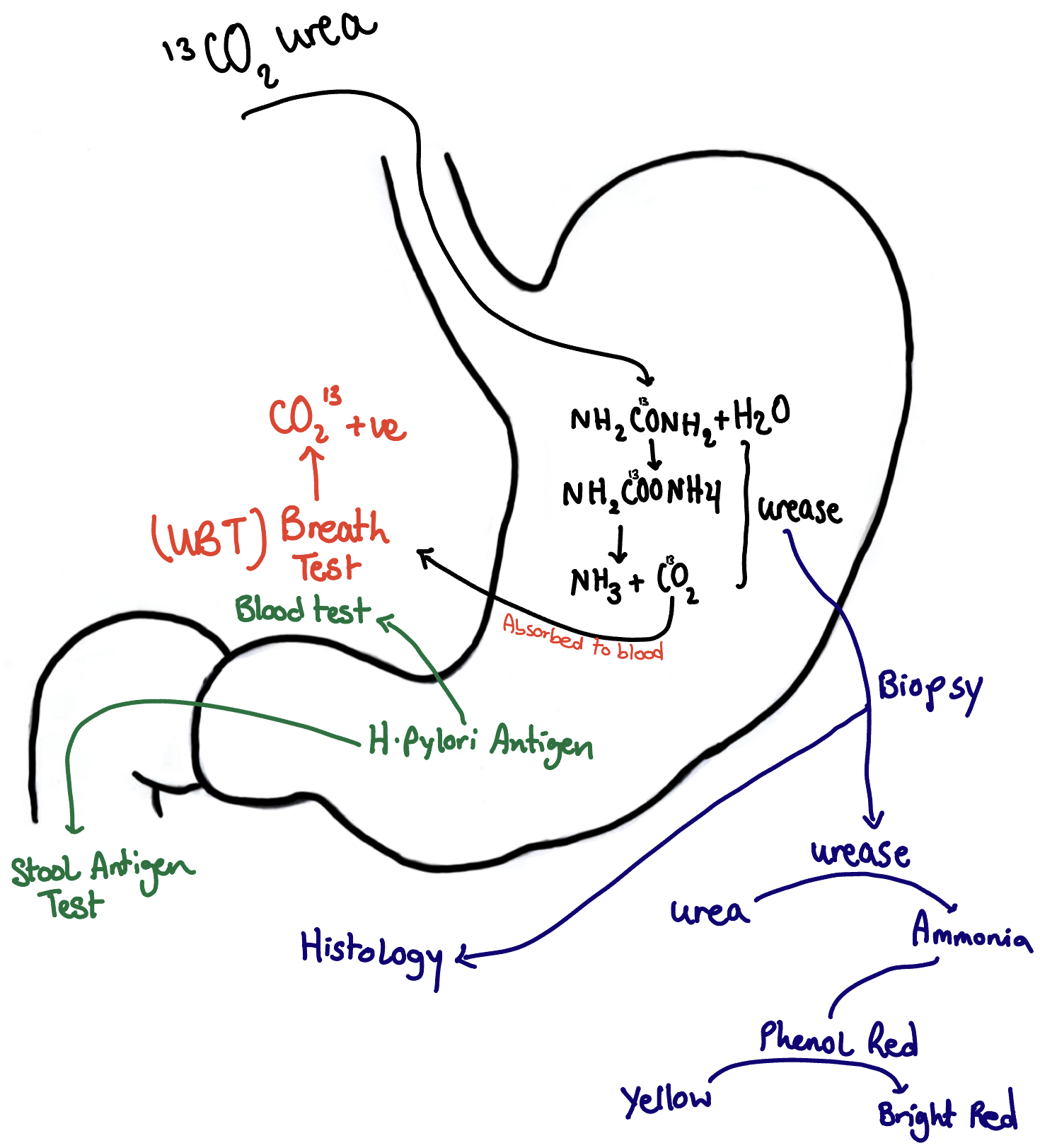
Diagram summarising H.Pylori investigations
H.Pylori treatment
Treatment aims to eradicate H. pylori, reduce the risk of peptic ulcer disease, ulcer bleeding and gastric malignancy, and the recurrence of gastritis and peptic ulcers.
H pylori Eradication
NICE recommends the following regimens, but always check your local guidelines as those maybe tailored according to local resistance patterns.
H. pylori Eradication Therapy |
|
|---|---|
First-Line (No Penicillin Allergy) |
A Proton Pump Inhibitor (PPI), plus:
|
First-Line (With Penicillin Allergy) |
A Proton Pump Inhibitor (PPI), plus:
|
Second-Line (No Penicillin Allergy) |
A Proton Pump Inhibitor (PPI), plus:
|
Second-Line (With Penicillin Allergy) |
A Proton Pump Inhibitor (PPI), plus:
|
|
¹ Choice depends on local resistance rates and the patient’s previous exposure. |
|
Peptic Ulcers
Definition
A breach in the mucosa of the GI tract due to an imbalance in acid production and mucosal defences resulting in ulceration that extends beyond the mucosa and into the submucosal layers.
Aetiology
Peptic ulcers occur when there is an excess in acid production and a reduction in the body’s defences against this acid. This imbalance is usually caused by multiple factors that increase that imbalance over a period of time. The factors that cause this imbalance are listed below.
H.Pylori infection
- H.pylori is found in 75% of gastric ulcers and 95% of duodenal ulcers.
Use of NSAIDs
Mechanism of action of NSAIDs
- In response to an injury, the body uses enzymes called Cyclo-oxygenase (COX) to produce prostaglandins. These prostaglandins are chemicals that trigger pain and swelling.
- NSAIDs relieve this by blocking the COX enzymes, which halts prostaglandin production.
This sounds good in theory, but the problem is COX enzymes are found in the majority of the body’s cells, so its inhibition will cause a variety of side effects including an increased risk of peptic ulcers.
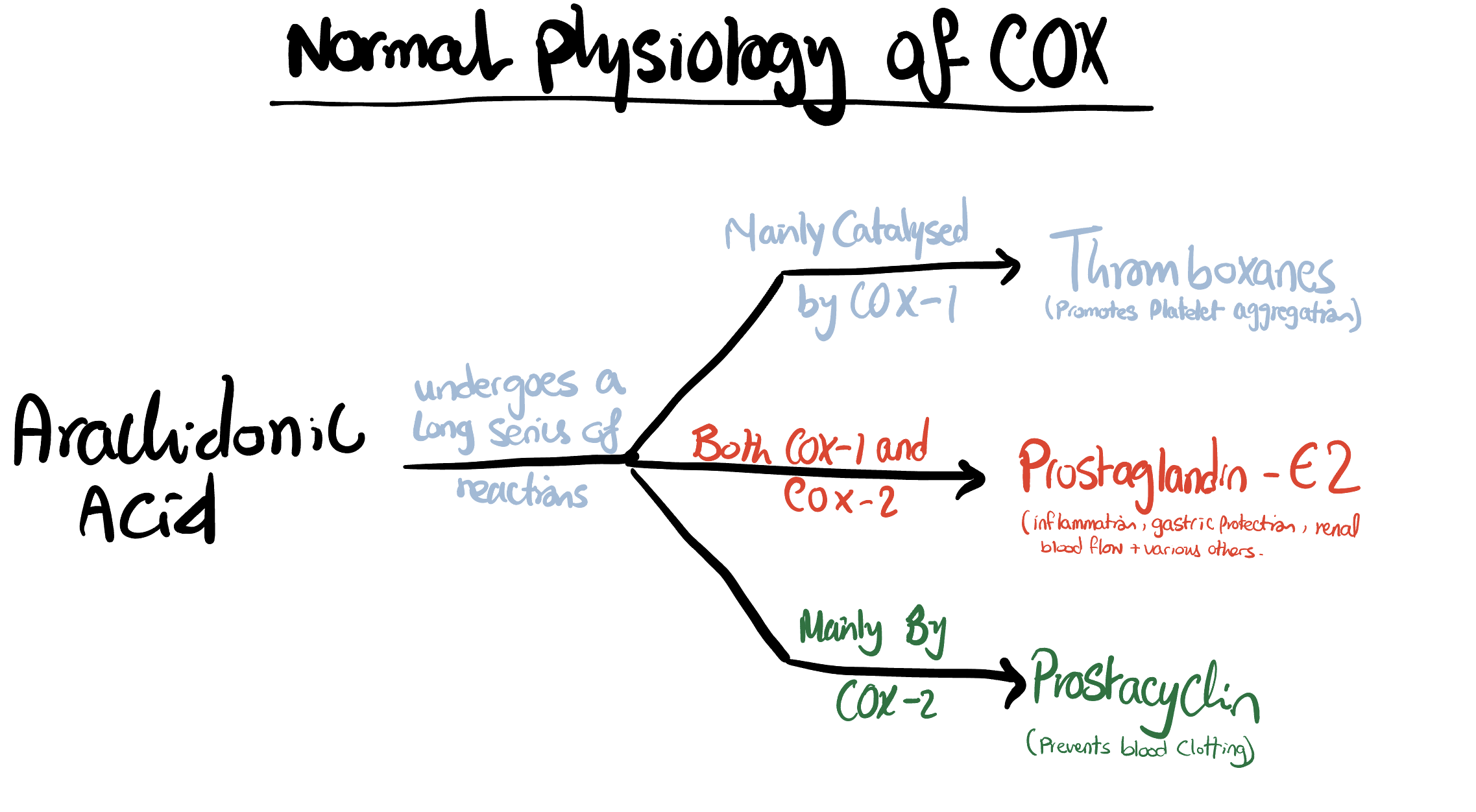
Normal physiology of COX enzymes.
Types of Cyclo-oxygenase enzymes
- There are 2 types of COX enzymes, COX-1 and COX-2
- The Cyclooxygenase (COX) enzymes, COX-1 and COX-2, are crucial in understanding how non-steroidal anti-inflammatory drugs (NSAIDs) work, their benefits, and their side effects.
- While both produce prostaglandins, they have very different primary roles in the body.
- COX-1:
- is considered a "housekeeping" enzyme because it's always active in many parts of the body, performing essential protective functions.
- Stomach Protection: COX-1 produces prostaglandins (PGE2) that help protect the lining of the stomach and intestines from the body's own gastric acid.
- Platelet Function: It produces thromboxane A2, a substance that causes platelets to stick together, which is vital for blood clotting after an injury.
- Kidney Function: It helps maintain normal blood flow to the kidneys. PGE2 produced from COX-1 cause vasodilation of the afferent arterioles of the kidneys. Inhibition of this reduces inflow of blood to the glomerulus and vasoconstriction of the afferent arterioles leading to an increased risk of AKI.
- COX-2
- The COX-2 enzyme is primarily an "inducible" enzyme. This means its levels are normally low but increase dramatically at sites of injury and inflammation.
- Pain and Inflammation: When you have an injury or arthritis, COX-2 is activated and produces prostaglandins that cause pain, swelling, redness, and heat.
- Fever: COX-2 is also involved in the fever response.
Why is this important in pharmacology:
- NSAIDs inhibit COX enzymes selectively, so knowing that different COX enzymes have different functions allows you to understand which side effect to expect from different drugs.
COX-1 inhibitors
Aspirin
- Aspirin is an NSAID commonly used in low doses as a anti-platelet to reduce risk of cardiovascular and cerebrovascular thromboembolic events.
- It is a unique NSAID because of it’s unique action of irreversibly inhibiting COX-1.
- At low doses, its primary effect is on platelets. By blocking COX-1 in platelets, it prevents the production of thromboxane A2.
- This makes the platelets less sticky and reduces the risk of formation of blood clots in arteries, which is why it’s a cornerstone for preventing cardiovascular events in at-risk patients.
- The problem is this inhibition of COX-1 also means a reduction in production of PGE-2 in the stomach.
This reduction in PGE-2 reduces the stomach’s production of protective mucus and reduces healing of gastric mucosa, increasing the risk of peptic ulcer formation in patients.
- It has been shown that the relative risk for gastrointestinal toxicity such as bleeding is as high as 4 in high-risk patients.
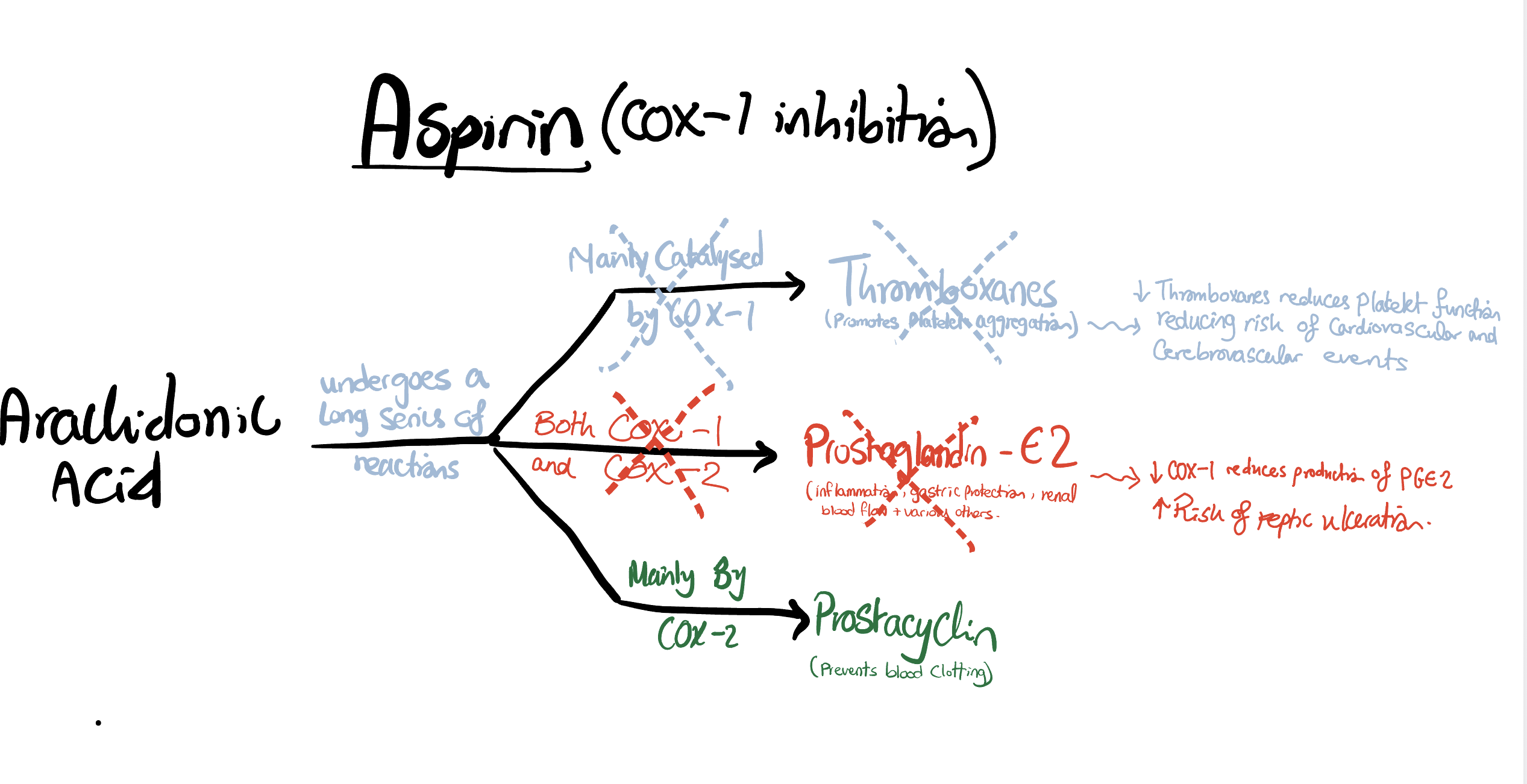
The mechanism of action of Aspirin is shown
Other NSAIDs
- They all work through the inhibition of COX.
- They have a wide variety of COX-1 to COX-2 inhibition ratios.
- Overall, they all increase risk of peptic ulcers, and the general advice is to avoid their use if possible, and if used, to be taken after food.
- It is generally recommended to prescribe a PPI for patients on NSAIDs long term, especially if they have other factors that may increase their risk of peptic ulcers.
Cox-2 Inhibitors
- The development of COX-2 inhibitors in the late 1990s aimed to target COX-2 and inhibit it reducing inflammation without reducing gastric protection
- Celecoxib (brand name Celebrex) was the first selective COX-2 inhibitor to be approved. It was used heavily at the time due to the reduction in risk of peptic ulcers compared to traditional NSAIDs.
- The idea was that inhibition of COX-2 will reduce inflammation and pain without reducing gastric protection which is primarily a function of COX-1.
- Unfortunately, the story took a dramatic turn when studies later confirmed they increased the risk of heart attacks and strokes, leading to the voluntary withdrawal of most COX-2 inhibitors from the worldwide market in 2004.
- This is because the inhibition of COX-2 causes a reduction in prostacyclins and also cause a build up of arachidonic acid, which primarily gets converted to thromboxanes. The increase in pro-thrombotic thromboxane and decrease in anti thrombotic prostacyclins in behind the increased risk of clotting.
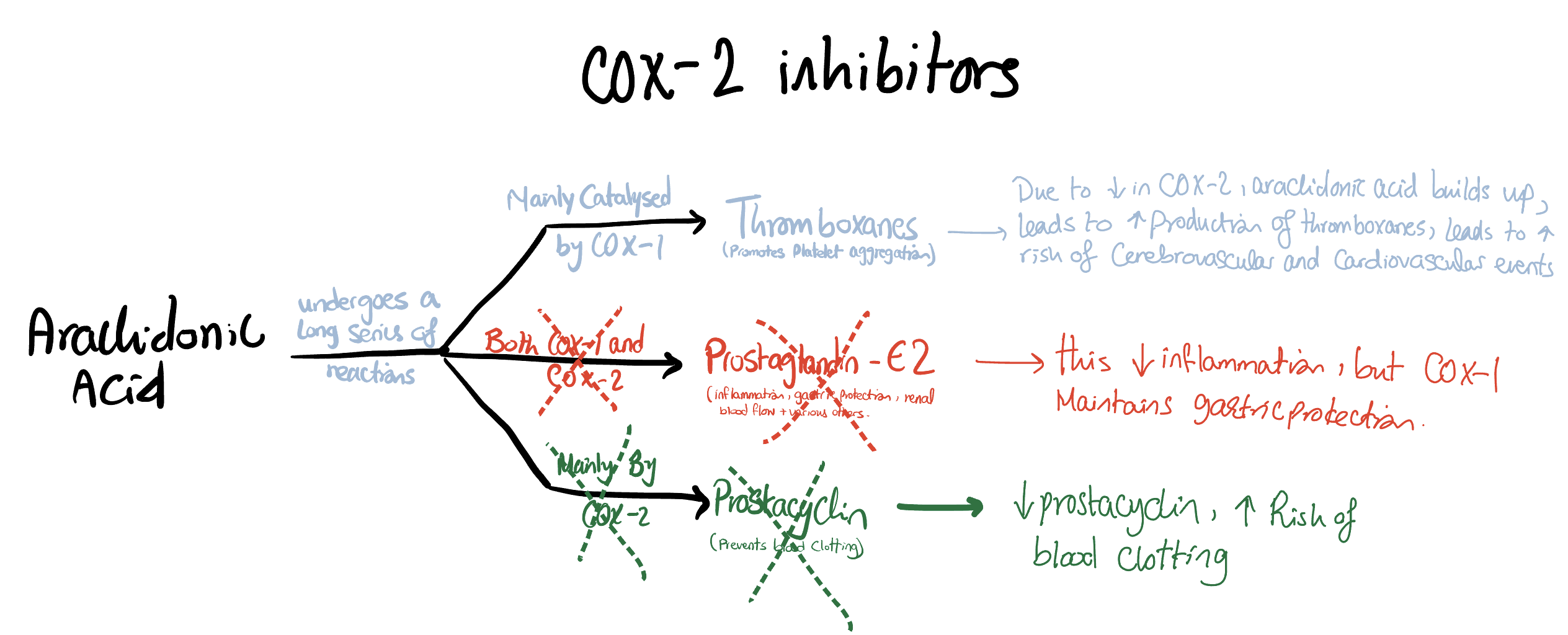
MOA of cox 2 inhibitors
smoking and alcohol
- Both smoking and alcohol increase risk of peptic ulceration.
- Alcohol in itself is an irritant to gastric mucosa and an intake of over 40 units of alcohol per week has been associated with a fourfold increase in risk of peptic ulcerations. Certain types of alcoholic drinks (spirits and beer) are associated with a higher risk compared to others such as wine.
- Nicotine is known to increase gastric acid production and to decrease gastric mucosa blood flow increasing risks of peptic ulceration.
Other medications
- Medications such as SSRIs, bispohospohates and steroids can also increase risk of peptic ulcers, especially when taken together.
- You should consider starting a PPI for patients starting the above medications, especially if they have other risk factors for peptic ulcer formation or if they have a history of it.
Stress ulcers
Stress, may that be physical or psychological, was thought to be the primary cause for peptic ulcers before the discovery of H.pylori. Now, it is thought to be a contributing factor in a small subset of patients who have had physiological stress.
Risk factors for gastric stress ulcers:
- Prolonged venitlation (over 48 hours)
- Coagulopathy
- Head trauma (cushing’s ulcer)
- Burns (curling ulcers)
- History of PUD
Cushing’s Ulcer
- It's also known as a neurogenic ulcer.
- It is caused by elevation in intracranial pressure (ICP).
- The elevated ICP is believed to cause overstimulation of the vagus nerve, leading to increased gastric acid production and subsequent ulcer formation.
- These are relatively rare as patients with high ICP are given prophylactic PPIs.
Curling’s Ulcer
- It is a type of stress ulcer which occurs as a response to severe burns.
- It is thought to be due to the reduced gastric perfusion which occurs during a period of low intravascular volume leading to necrosis of the gastric wall and fomation of ulcers.
- Curling’s ulcer are seen in over 10% of severe burns patients, again prompting the use of prophylactic PPI use in this patient population
Zollinger-Ellison Syndrome
- a rare condition caused by the presence of gastrin producing tumours (grastrinomas) leading to excessive gastri acid production and multiple peptic ulcers.
- Gastrinomas are usually found in the anatomical area known as the “gastrinoma triangle” formed by the following:
- Porta hepatis: The area where the hepatic artery, portal vein, and bile duct enter the liver.
- Duodenal sweep: The C-shaped curve of the duodenum.
- Pancreatic head: The portion of the pancreas closest to the duodenum.
Histopathology
- Peptic ulcers have 4 distinct layers from superficial to deep:
- Necortic debris (a layer of fibropurulent exudate)
- Inflammation: Non specific acute inflammatory cells
- Granulation tissue
- Fibrosis
Clinical presentation
Symptoms:
Epigastric pain
- Patients report a recurrent burning epigastric pain.
- Classically, patients point with one finger to the site of pain in the epigastrium.
- Symptoms are similar regardless of the location of the ulcer (duodenal vs gastric), but classically, duodenal ulcers tend to be worse when the patient is hungry, while peptic ulcers tend to get worse with food.
Malaena / haematemesis
- Peptic ulcers can present with upper GI bleeding. This can be acute or chronic.
- Chronic bleeding usually presents as generalised tiredness, weakness, pallor, all associated with generalised abdominal pain. The aforementioned symptoms are due to a microcytic anaemia secondary to the chronic blood loss.
- Acute bleeding presents as one of, or a combination of haematemesis (vomiting up blood) and malaena.
- Malaena is a medical term that describes black tarry smelly stool caused by the presence of digested blood in the stool.
- This can be reported by patients, or seen on a glove on Per rectal (PR) examination.
- If a significant volume of blood has been lost, patients can present with symptoms or haemorrhagic hypovolaemic shock.
Perforated peptic ulcers:
- peptic ulcers can progress to affect the full thickness of the gastric wall leading to a perforation of the duodenum or the stomach.
- This causes GI tract contents to leak into the abdominal wall leading to peritonitis.
- This patient group will present with a chronic ongoing epigastric abdominal pain which suddenly worsens to a 10/10 pain.
- This is due to the presence of pain due to a chronic ulceration which then worsens after a perforation.
Gastric outlet obstruction:
- An untreated ulcer, can cause swelling and scarring, which can cause a blockage at the pylorus leading to gastric outlet obstruction.
- This leads to vomiting, abdominal distension and unintentional weight loss.
Features on clinical examination:
Abdominal examination:
- Patients will report pain in the epigastrium on examination. This may be associated with guarding.
- Any evidence of peritonism, percussion tenderness, or severe pain should raise alarm bells to the possibility of a perforation
- Abdominal distension and intractable vomiting should raise alarm bells for a potential gastric outlet obstruction.
Upper GI bleeding:
- Patients may vomit fresh red blood or semi digested blood (resembling coffee grounds).
- A PR examination may reveal melaena on the glove.
Is it actually Malaena?
- When you get a report of melaena, resist the urge to immediately call in the cavalry. Your first move shouldn’t be to order a scope—it should be to play detective. Politely ask the nursing team to preserve the evidence and insist on inspecting the stool yourself.
- While it’s hardly the highlight of your day, an experienced clinician’s eye can readily distinguish a genuinely sinister, tarry melaena from simple dark stools—a crucial nuance a newly appointed nurse might miss. Cracking this case yourself spares your patient from a cascade of invasive and costly investigations.
- Always remember to rule out the most common imposter: oral iron supplements.
Investigations:
observations
- an uncomplicated peptic ulcer should not cause any derangement in a patient’s physiology.
- If observations point to haemodynamic instability (tachycardia, hypotension), then complications of peptic ulcers need to be considered:
- Bleeding: hypovolaemic haemorrhagic shock can be seen in patients with a bleeding peptic ulcer. There patients are usually not peritonitic on examination and you will likely note features of bleeding as aforementioned in the clinical examination section.
- Perforation: a perforated peptic ulcer can quickly lead to peritonitis and sepsis, leading to septic shock. This patient group will be peritonitic on examination and likely have a temperature.
Bloods
Full blood count:
- A chronic bleeding ulcer will cause anaemia due to the chronic slow ongoing blood loss. This anaemia will be microcytic (have a low MCV).
- An acutely bleeding peptic ulcer may not necessarily cause a drop in Hb initially.
Interpretting Hb in an acute bleeding situation
Why a Normal Haemoglobin Can Be Deceiving in an Acute Bleed
- In an acute bleed, a normal haemoglobin (Hb) level on a blood test can be dangerously misleading. The reason lies in understanding what the test actually measures: concentration, not total volume .
- A blood test reports Hb in grams per litre (g/L). It’s a measure of the concentration of haemoglobin, and not the volume of Hb.
The Ribena Analogy
- Think of your blood as a full glass of Ribena. The concentration of the squash gives it its colour.
- If you suddenly spill half of the Ribena, the liquid still in the glass has the exact same concentration and colour as before. You’ve lost a large volume, but the strength of the remaining drink is unchanged.
- This is what happens in an acute bleed. The patient has lost a large volume of blood, but the blood remaining in their vessels is, for a short time, unchanged in concentration. Their initial Hb reading can therefore appear normal.
When Does the Haemoglobin Drop?
- The Hb level only begins to fall when the "glass" gets refilled with a weaker liquid. This happens when:
- 1. The body compensates by shifting fluid from its tissues into the blood vessels.
- 2. Medical staff give IV fluids during resuscitation.
- Both actions are like topping up the half-empty glass of Ribena with water. The total volume increases back to normal, but the mixture is now diluted and paler. This is haemodilution, and it's only at this point that the Hb concentration on a blood test will drop.

Illustration depicting the Ribena analogy
Conclusion:
- Do not be falsely reassured by a normal haemoglobin in an acute bleeding situation. The initial lab result is a snapshot of the past, not the present reality. Instead, trust the real-time clinical picture:
- Haemodynamic stability (heart rate and blood pressure)
- Signs of shock (e.g., high lactate)
- Visible or estimated blood loss
- These factors reveal the true extent of the bleed long before the haemoglobin level does.
Iron studies
- Patients with peptic ulcers chronically losing small volumes of blood over a long period will be found to have iron deficiency anaemia.
How to interpret Iron studies in Iron deficiency:
Here’s what you would typically see in the lab results:
Serum Ferritin: ⬇️ Low:
- Ferritin is the body’s main iron storage protein. A low ferritin level indicates that these iron stores are depleted. It’s often the first indicator to become abnormal.
- Ferritin is also an acute phase reactant, so it can be falsely elevated during an infection or post surgery, masking iron deficiency. This is why you have to interpret this in the context of the other bloods below.
Serum Iron: ⬇️ Low
- This test measures the amount of iron circulating in the blood. As stores are used up, the amount of iron available in circulation also falls.
Total Iron-Binding Capacity (TIBC): ⬆️ High
- TIBC is an indirect measure of transferrin, the protein that transports iron in the blood. When iron levels are low, the liver produces more transferrin in an attempt to "catch" as much available iron as possible.
- A high TIBC means there is a large capacity to bind iron, but not enough iron to bind to.
Transferrin Saturation (TSAT): ⬇️ Low
Putting It All Together: An Analogy
Think of it like a city’s taxi service during a fuel shortage.
- Serum Ferritin is the fuel reserve at the depot. In IDA, the depot is empty (low ferritin).
- Serum Iron is the amount oF fuel currently in the taxis. With a shortage, there is very little fuel circulating (low serum iron).
- TIBC represents the total number of taxis (transferrin) the city has sent out looking for fuel. In a shortage, the city sends out more taxis hoping to find any available fuel (high TIBC).
- Transferrin Saturation is the percentage of taxis that actually have fuel. Because there’s a fuel shortage and lots of empty taxis, this percentage is very low.
Inflammatory markers:
- In an uncomplicated peptic ulcer, you would expect normal inflammatory markers.
- If this is accompanied by gastritis and intractable vomiting, you may note a mild rise in white cell count in response to vomiting.
- A significant rise in CRP and WCC should prompt you to strongly consider a perforation or an alternative diagnosis in the acute setting.
Amylase
- This should be checked in patients with epigastric pain to rule out pancreatitis.
- A small rise in amylase maybe seen in a perforated peptic ulcer, but an amylase over 3x the top of the normal range (around 300) would strongly suggest a diagnosis of pancreatitis.
Urea (BUN)
- Urea is normally a measure of kidney function/ patient’s fluid status. It will rise, along with creatinine, in patients who are dehydrated, in acute kidney injury, or in patients with significant CKD.
- A rise in urea, without an associated rise in creatinine, should prompt you to consider upper GI bleeding secondary, potentially secondary to a peptic ulcer.
- This is because in an upper GI bleed, the blood will be digested by enzymes in the GI tract to amino acids. These amino acids will be absorbed by the GI tract, taken to the liver by the portal vein, and de-aminated.
- This process produces ammonia, a toxic substance that the liver promptly converts into urea.
- This newly synthesized urea is then released into the bloodstream, leading to an elevated BUN level.
- In essence, the blood from the bleed acts as a high-protein meal, directly increasing urea production.
Imaging
CT abdomen/pelvis:- A CT abdomen and pelvis is not the right investigation to assess patients with an uncomplicated peptic ulcer, but it should be the first line investigation if you are looking to rule out a perforation.
- A perforation will show free fluid and free air around the stomach/duodenum/ in the lesser sac.
- In an acute bleed without a source, you may consider performing a triple phase CT scan to look for the source of bleeding, but this will only show the source of bleeding, if a significant volume of blood is actively being bled during the time of the scan.
- An erect chest XR may show a pneumoperitoneum (air under the diaphragm) in a perforated peptic ulcer. This sign is specific (low risk of false positive), but not sensitive (high risk of false negative).
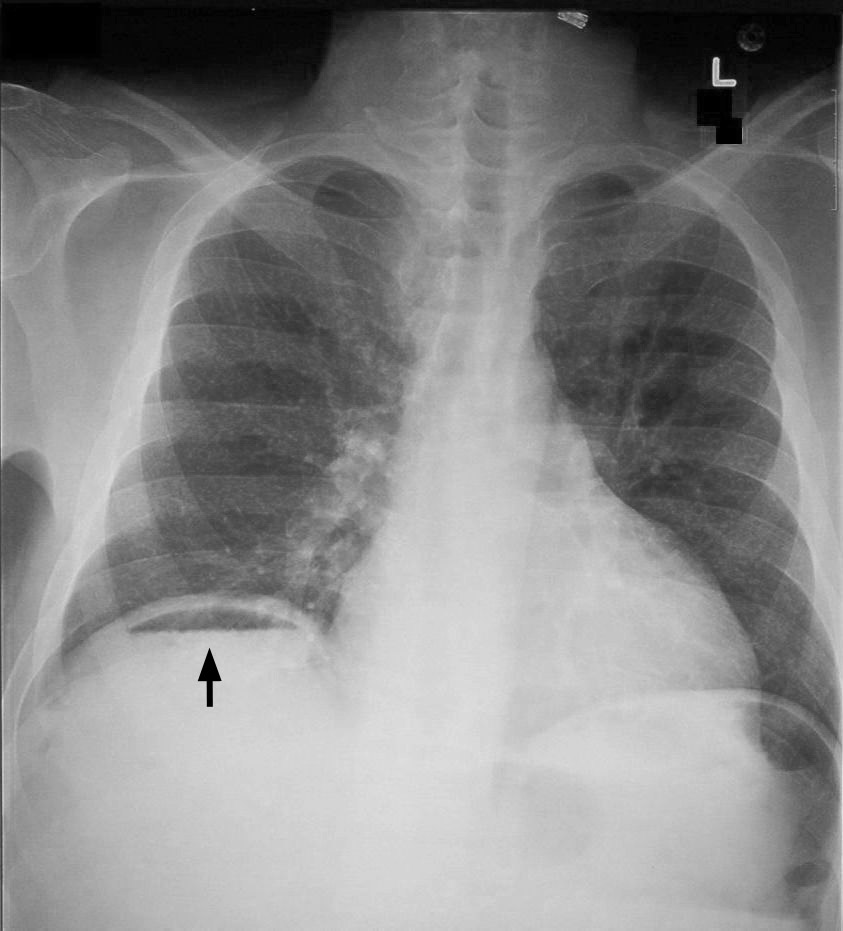
Pneumoperitoneum on Chest CR
- Riggler’s sign can be seen in an abdominal XR. This is a sign where you can see the 2 sides of a wall of a hollow viscus and it indicates the presence of free air in the abdomen. It is not very specific or sensitive.
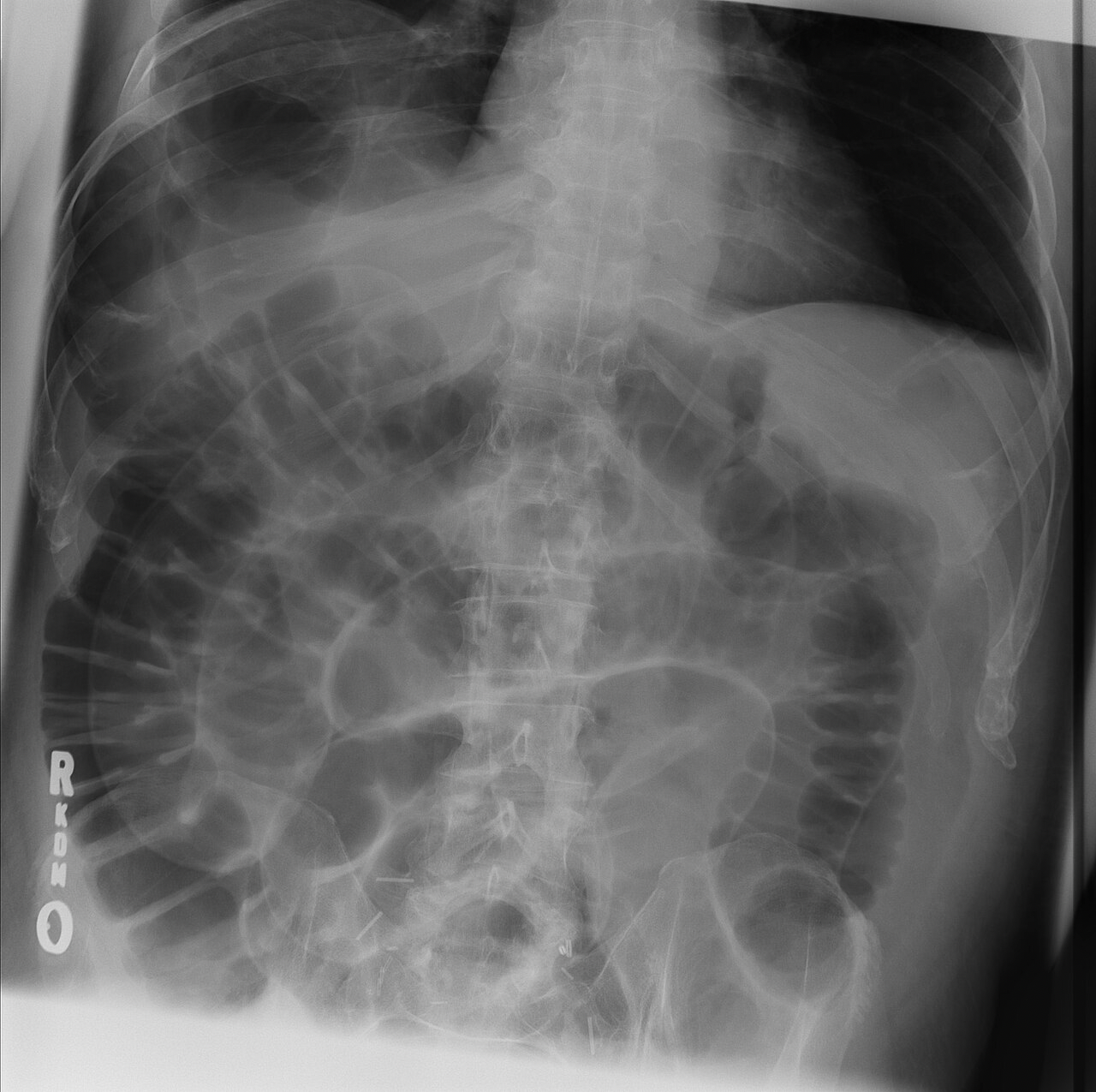
Riggler’s sign on AXR
Endoscopy
- An OGD for direct visualisation of peptic ulcers and the diagnosis of H.pylori should be requested in patients with high suspicion of peptic ulcer disease.
- It should also be requested in patients with unexplained iron deficiency anaemia, along with a colonoscopy to rule out a chronically bleeding ulcer leading to blood loss over a long period and anaemia.
- Patients with an acute upper GI bleed should get an urgent endoscopy to assess for the cause of bleeding and to allow intervention to stop the acute bleeding.
- Endoscopic clips, thermal coagulation, injection of vasoactive or sclerosing agent can be used to acheive haemostasis.
- This achieves haemostasis, and significantly reduces the risk of re-bleeding, need for surgery and overall mortality.
Scoring systems for UGI bleeding
Glasgow Blatchford score
- This is a scoring system used to stratify upper GI bleeding patients who are low risk and for outpatient management, vs patients who are for inpatient management.
- This is considered the gold standard pre-endoscopy scoring system in various guidelines including the WSES, AUGIS, BSG and SAM.
Glasgow-Blatchford Score (GBS) Calculator
Total Glasgow-Blatchford Score
0
Awaiting calculation…
Forrest classification:
- This score stratifies severity of upper GI bleeding based on endoscopic findings.
- This is the gold standard scoring system for use post endoscopy according to various guidelienes including AUGIS and WSES.
Forrest Classification Risk Calculator
Rebleeding Rate
–%
Mortality
–%
Rockall score:
- This a scoring system that determines severity of upper GI bleeding, and estimates mortality of those patients.
- A pre-endoscopy and post-endoscopy score can be calculated using this scoring system.
- Pre-endoscopy score assesses a patients age, presence of features of shock and presence of comorbidities.
- The post endocscopy score combines this with the endoscopic findings to come up with mortality risk and risk of rebleeding after intervention.
- It is less validated than the Glasgow-Blatchford and Forrest, but is still used in some local hospital guidelines.
Management of peptic ulcer disease
Management of peptic ulcer disease varies according to what complications patients have. The detailed management according to complications is discussed below.
Uncomplicated peptic ulcers:
- The aims of treatment are to promote ulcer healing, manage symptoms, treat H.Pylori infection if detected and reduce the risk of ulcer complications and recurrence (NICE CKS).
- Lifestyle management:
- Advise healthy eating, weight loss in obese patients, smoking cessation and reduction of alcohol intake.
- Initial management:
- Review need for any drugs that may have triggered the peptic ulcer (NSAIDS, bisphosphonates, SSRIs etc).
- Investigate patients for presence of H.Pylori and use eradiation therapy if detected (see H.pylori section).
- Use of Antacids/ Alginate can be considered for short term symptom control, but should not be used long term due to risk of electrolyte imbalances and drug interactions.
- Patients with a suspected peptic ulcer should be started on a PPI.
- Patients who dont respond to therapy should be assessed for less common causes of ulcers such as Crohn’s and Zollinger Ellison syndrome.
- Endoscopy:
- Urgent endoscopic investigation is required for patients with dysphagia, significant acute gastrointestinal bleeding, or in those aged 55 years and over with unexplained weight loss and symptoms of upper abdominal pain, reflux or dyspepsia.
- Gastric ulcers need to be reassessed in 6-8 weeks post endoscopy and biopsies should be taken to ensure this ulceration is not a missed cancer. This follow up is not required for duodenal ulcers.
Bleeding peptic ulcers
This is primarily managed endoscopically as over 90% of bleeding peptic ulcers can be managed without the need for surgery
- Haemostasis can be acheived endocscopically through use of endoscopic clips, thermal coagulation, injection of adrenaline or sclerosing agents.
- Recurrent bleeding will require a re-look endoscopy and is still managed endoscopically if the patient is haemodynamically stable.
- Bleeding that cannot be managed endoscopically or patients with haemodynamic instability will require surgical intervention.
- Details on this can be found in the surgical view tab!
Perforated peptic ulcer disease
- Patients will likely present in severe pain and shock.
- A-E assessment is required.
- Airway:
- Assess: Check for airway patency. In a patient with a decreased level of consciousness due to shock, the airway may be at risk.
- Intervene: Ensure the airway is clear. Use simple manoeuvres like a head-tilt chin-lift if necessary. Prepare for advanced airway management (intubation) if the patient is unable to protect their own airway (e.g., GCS < 8).
- B: Breathing
- Assess: Check respiratory rate, effort, and oxygen saturation (SpO2). Sepsis and pain can cause a rapid, shallow breathing pattern.
- Intervene: Administer high-flow oxygen via a non-rebreather mask to maintain oxygen saturations above 94%. This is a key part of the Sepsis Six protocol and is crucial to maximise oxygen delivery to tissues during shock.
- C: Circulation
This is often the most critical component in this scenario. The patient is frequently in septic and/or hypovolemic shock.
- Assess: Measure heart rate and blood pressure. Assess capillary refill time and peripheral temperature.
- Intervene:
- IV Access: Secure two large-bore intravenous (IV) cannulas.
- Bloods: Draw urgent bloods including: Full Blood Count, Urea & Electrolytes, Liver Function Tests, C-Reactive Protein, coagulation screen, and a Group & Save. A venous blood gas (VBG) is essential to check lactate and assess the degree of metabolic acidosis.
- Fluid Resuscitation: Begin immediate fluid resuscitation with a warmed crystalloid solution (e.g., Hartmann’s or 0.9% saline). Start with a 500ml fluid bolus over 15 minutes and reassess the patient’s heart rate, blood pressure, and perfusion. Continue with further boluses as needed to restore hemodynamic stability.
- Sepsis Management: Administer broad-spectrum IV antibiotics as per local guidelines (covering gram-negative, gram-positive, and anaerobic organisms) as soon as possible. Peritonitis from a perforated viscus is a source of sepsis. Antifungal agents may be considered based on patient risk factors.
- Monitoring: Insert an indwelling urinary catheter to accurately monitor urine output (aiming for >0.5 ml/kg/hr), which is a key indicator of kidney perfusion and fluid status. Re-check lactate after initial resuscitation to ensure it is clearing.
- D: Disability
- Assess: Evaluate the patient’s neurological status using the AVPU scale (Alert, Voice, Pain, Unresponsive) or the Glasgow Coma Scale (GCS). Check pupil size and reactivity.
- Intervene: A low GCS is a concerning sign, often secondary to severe shock and tissue hypoperfusion. Check blood glucose to rule out hypoglycemia as a contributing factor.
- E: Exposure
- Assess: Fully expose the patient to perform a thorough head-to-toe examination, paying close attention to the abdomen. Look for any other sources of sepsis or injury. Prevent hypothermia by keeping the patient covered and warm.
- Key Finding: The abdominal examination will typically reveal generalised peritonitis with a board-like rigidity.
Further Management and Investigations
- Analgesia: Provide strong pain relief with intravenous opiates.
- NG Tube: Consider inserting a nasogastric (NG) tube to decompress the stomach, which can reduce further spillage of gastric contents into the peritoneum.
- Imaging:
- For a hemodynamically stable patient, a CT scan of the abdomen and pelvis is the gold standard investigation. It can confirm the diagnosis by identifying free intraperitoneal air (pneumoperitoneum) and fluid, and may help locate the site of perforation.
- If a CT is unavailable or the patient is too unstable too get through a CT scan, patients should be taken straight to theatre for an exploratory laparotomy, washout, repair of the perforation (more details below).
Surgical management
- See the surgery tab for detailed information!
- open and laparoscopic approaches can be used.
- Graham’s patch and modified Cellan Jones repairs can be used to repair the defect and cover if with omentum and then a thorough washout is peformed.
Gastric Cancer
Introduction
- Gastric cancer is a global health concern, ranking as the 4th leading cause of cancer deaths and the 5th most commonly diagnosed cancer.
- The prognosis is dismal, with an average 5-year survival rate of less than 20%, mainly because of late diagnosis, due to it being clinically silent until the later stages.
Classification of Gastric Cancer
over 90% of gastric cancers are adenocarcinomas. Other rarer malignancies such as Gastrointestinal stromal tumours (GIST) and neuroendocrine tumours also exist. We will focus on adenocarcinomas in this page.
There are several systems for classifying gastric cancer based on its microscopic appearance (histopathology). The most frequently used are the World Health Organization (WHO) and the Japanese Gastric Cancer Association classifications. Another key system is the Laurén classification, which divides gastric cancer into three main types: intestinal, diffuse, and mixed. The WHO classification, popular in Western countries, identifies five main histological subtypes: tubular, papillary, poorly cohesive (which includes signet ring cell cancer), mucinous, and mixed.
The Lauren classification is a widely used system that divides gastric cancers into three main subtypes—intestinal, diffuse, and mixed —based on their microscopic appearance. The location of the tumor can often provide clues to its underlying cause and type.
The table below compares different classification systems
| Feature | Lauren Classification | WHO classification |
|---|---|---|
| Primary basis | Based on the tumor’s growth pattern and cell cohesion. | Based on the predominant microscopic (histological) structure. |
| Main subtypes | Intestinal: Gland-like structures, often associated with chronic inflammation. | Tubular: Cancer cells form tube-like structures. |
| Diffuse: Poorly cohesive cells that infiltrate the stomach wall without forming glands. | Papillary: Cancer cells form finger-like projections. | |
| Mixed: Contains elements of both intestinal and diffuse types. | Poorly Cohesive: Includes **signet ring cell** carcinoma; cells are not stuck together and infiltrate individually. | |
| Mucinous: The tumor produces a large amount of extracellular mucus. | ||
| Mixed: Composed of a mixture of the other subtypes. | ||
| Common Use | Widely used in research and clinical practice to predict prognosis. | Widely used in pathology reports, especially in Western countries, for standardized diagnosis. |
Below, we will focus on the Lauren classification
1. Intestinal-Type Adenocarcinoma
This is the more common subtype of gastric cancer.
Characteristics and Aetiology
The defining feature of intestinal-type cancer is its tendency to form gland-like structures, resembling intestinal cancer. Its development is strongly linked to chronic inflammation, most commonly from Helicobacter pylori infection. The progression from infection to cancer is well-defined and the process is referred to as Correa's cascade:
- Chronic Gastritis: An initial, persistent inflammation of the stomach lining (often in the antrum, or lower part) caused by H. pylori.
- Atrophic Gastritis: Over time, the inflammation leads to the loss of stomach glands and reduced acid secretion. This is a major risk factor, as pernicious anaemia and chronic atrophic gastritis can increase cancer risk up to 6-fold.
- Intestinal Metaplasia: The damaged, low-acid stomach lining is replaced by cells that resemble the lining of the intestines.
- Dysplasia & Adenocarcinoma: This new intestinal-type tissue is unstable and can develop into precancerous cells (dysplasia) and eventually, cancer.
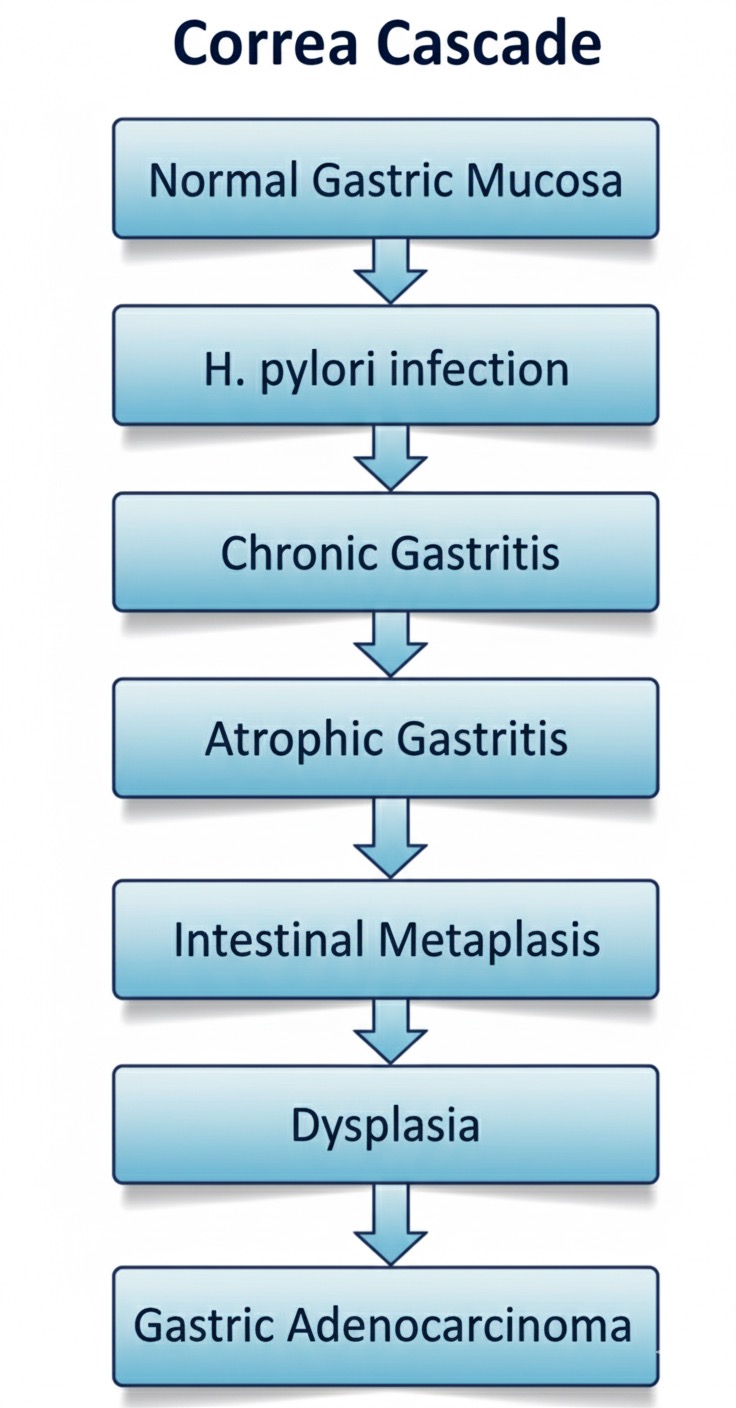
Diagram depicting the sequence of Correa’s cascade.
Beyond inflammation, H. pylori also contributes by causing direct DNA mutations through reactive oxygen species (ROS) and by silencing tumor suppressor genes through a process called hypermethylation.
Epidemiology and Features
- Location: Because the initial H. pylori infection often occurs in the lower part of the stomach (antrum), intestinal-type cancer is usually found in the distal (lower) stomach.
- Trends: The incidence of this cancer has declined significantly in developed nations due to better sanitation and the treatment of H. pylori.
- Gender: It is more common in men.
2. Diffuse-Type Adenocarcinoma
This subtype is less common and generally has a worse prognosis.
Characteristics and Aetiology
- Diffuse-type cancer is defined by its lack of gland formation. Instead, individual cancer cells infiltrate and thicken the stomach wall without forming a cohesive mass. This is due to a loss of intercellular adhesion.
- Its causes are strongly linked to genetic and inherited factors:
- While most gastric cancers are sporadic, about 5-10% have a familial or genetic link.
- Hereditary Diffuse Gastric Cancer (HDGC): This inherited syndrome, caused by a mutation in the CDH1 gene, dramatically increases the risk of diffuse-type cancer. Prophylactic surgical removal of the stomach (gastrectomy) is often recommended for individuals with this mutation between the ages of 20 and 40.
- Blood Type: Individuals with Type A blood have a ~20% higher risk of gastric cancer, particularly the diffuse type.
Other factors like smoking and a diet high in salted or poorly preserved foods are also associated with a general increased risk of gastric cancer, although their specific connection to the diffuse type is less defined.
Other Genetic Syndromes
Besides HDGC, several other hereditary syndromes are associated with an increased risk of gastric cancer, including:
- Hereditary Non-Polyposis Colon Cancer (13% lifetime risk, mostly intestinal type)
- Familial Adenomatous Polyposis (10% risk)
- Peutz-Jeghers Syndrome (29% risk)
- Juvenile Polyposis Syndrome (21% risk)
Epidemiology and Features
- Trends: The incidence of diffuse-type cancer has declined more slowly than the intestinal type. As a result, it now accounts for a larger proportion of all gastric cancers.
- Gender: It occurs equally in both men and women.
Other Considerations:
Gastrooesophageal Junction (GEJ) Cancer
Tumours located where the oesophagus meets the stomach have a distinct cause. They are typically linked to chronic gastro-oesophageal reflux disease (GORD) and obesity.
Patient Presentation
History
Early symptoms of gastric cancer are usually subtle and easily mistaken for less severe conditions in its early stages, delaying presentation and diagnosis
- Common early symptoms include:
- Persistent indigestion
- Stomach discomfort
- Feeling of fullness or bloating after small meals
- As the disease progresses, patients experience more severe symptoms such as:
- Unexplained weight loss
- Persistent nausea or vomiting
- Difficulty swallowing
- Visible signs of gastrointestinal bleeding, such as black or bloody stools
- A palpable mass in the abdomen
- Due to the nonspecific nature of these symptoms, gastric cancer is frequently diagnosed at a later stage. The lack of specific symptoms can lead to a delayed diagnosis.
- In high-risk populations that undergo screening endoscopy, such as in Japan and South Korea, gastric cancer is often diagnosed at an early stage.
Examination
Physical examination findings are typically evident only in advanced or metastatic stages. These may include:
- A palpable epigastric mass:
- This happens in late stage gastric cancer, as early stage tumours are usually too small to be appreciated on abdominal palpation.
- features of iron deficiency anaemia: patients may appear pale, experience conjunctival pallor.
- Features of weight loss:
- To a seasoned clinician, a patient wearing clothes that are a size too big can be more concerning than a celebration. While intentional weight loss often comes with a new wardrobe, unintentional weight loss can lead to the telltale sign of ill-fitting clothes.
- Taking a full history helps determine if the weight loss is intentional. If a patient doesn't regularly weigh themselves, a clinician can ask about changes in how their clothes fit, the need to tighten a belt, or if a partner has noticed any weight loss. This physical sign is an important clue that a deeper medical investigation is needed.
- Virchow node: Left supraclavicular adenopathy.
- Stomach lymphatics drain into regional nodes, then to the cisterna chyli and thoracic duct, which empties into the left subclavian vein – explaining why gastric cancer can metastasize to left supraclavicular (Virchow's) nodes.
- Sister Mary Joseph node: A solid painful periumbilical lymph node.
- The umbilicus is a point of convergence for several embryonic remnant structures, such as the falciform ligament and the median umbilical ligament. Cancer cells can spread along these ligaments to reach the umbilical region.
- Ascites: Fluid build-up in the abdomen due to peritoneal carcinomatosis.
Investigations
| Procedure | Purpose |
|---|---|
| FBC | Iron deficiency anaemia: an early sign of most GI cancers, due to occult loss of blood over a long period of time. |
| Renal and liver function | Assess renal and liver function baseline to allow determining appropriate therapeutic options |
| Endoscopy and biopsy | see below |
| CT of thorax + abdomen ± pelvis | • A CT scan may show thickening in the stomach. This is a nonspecific feature and may represent gastritis and not necessarily a malignancy. |
Imaging of gastric Cancers
- CT scanning
- A scan may also show lymphadenopathy or metastasis, raising suspicion for a malignant process.
- A CT chest abdomen and pelvis is utilised for TNM staging of the tumour to guide further management.
- Endoscopic Ultrasound
- Allows accurate assessment of T and N stage in potentially operable tumours.
- Allows determining the extent of invasion into the gastric wall and to determine the proximal and distal extent of tumour
- Diagnostic laparoscopy + washings
- Allows exclusion of occult metastatic disease involving peritoneum/diaphragm. Studies quote 15-30% of patients get diagnosed with M1 (metastatic disease during pre-resection diagnostic laparoscopy.
- PET CT/ PET imaging
- May improve detection of occult metastatic disease in some cases. Often negative in diffuse-type gastric.
More notes on OGDs
- Gold Standard: The primary method for diagnosing gastric cancer is through endoscopic examination and forceps biopsies. This should be requested for patients with new onset dysphagia, age >55 years, weight loss, upper abdominal pain, reflux and or dyspepsia.
- This allows both visualisation of any lesions but also allows biopsies to be taken for histopathological assessment.
- Biopsy Requirements: To ensure enough material for analysis and increase diagnostic accuracy, 5-8 biopsies are recommended, particularly for ulcerated lesions
- HER2/neu protein expression – this will allow assessment for targeted monoclonal therapies if present
- Advanced Imaging:
- Narrow-band imaging or chromoendoscopy, combined with magnifying endoscopy, helps evaluate the details of the mucosal surface.
- Endoscopic ultrasonography (EUS) is used to identify cancer infiltration within the gastric wall.
- Diagnostic & Therapeutic Procedures:
- Endoscopic mucosal resection (EMR) and endoscopic submucosal dissection (ESD) can be used for diagnosis.
- These procedures also provide reliable staging information and can treat superficial lesions like dysplasia or intramucosal carcinoma.
Management of gastric cancer
Management of gastric cancer is a complex decision making process which involves an MDT of surgeons, oncologists, nutritionists and radiologists.
Gastric cancer treatment follows a stage-based approach:
- Early-stage: Endoscopic resection or surgery with lymph node dissection offers curative potential (see surgery section)
- Locally advanced: Perioperative chemotherapy with surgery
- Advanced/metastatic: Chemotherapy focusing on symptom control and survival extension
Treatment Modalities
- Endoscopic Resection: For early tumors confined to mucosa/superficial submucosa without lymph node risk
- Surgery: Primary curative approach for early/intermediate tumors (gastrectomy with lymphadenectomy)
- Chemotherapy: Neoadjuvant, adjuvant, or palliative based on disease stage
- Radiation: Primarily for palliation or combined with chemotherapy for advanced disease
- Targeted/Immunotherapy: For specific molecular subtypes to improve outcomes
Key Management Principles
- Staging: Critical for treatment selection
- Multimodal Approach: Combining treatments for optimal outcomes
- Surgical Goals: Clear margins and complete lymphadenectomy when resectable
- Personalized Medicine: Molecular profiling to guide targeted therapies
- Supportive Care: Managing comorbidities and optimizing quality of life
Surgery tab title
“Surgery content”Choose Your Quiz Type
Knowledge Quiz
Quiz Progress
Question: 1 / 5
Answered: 0
Remaining: 5